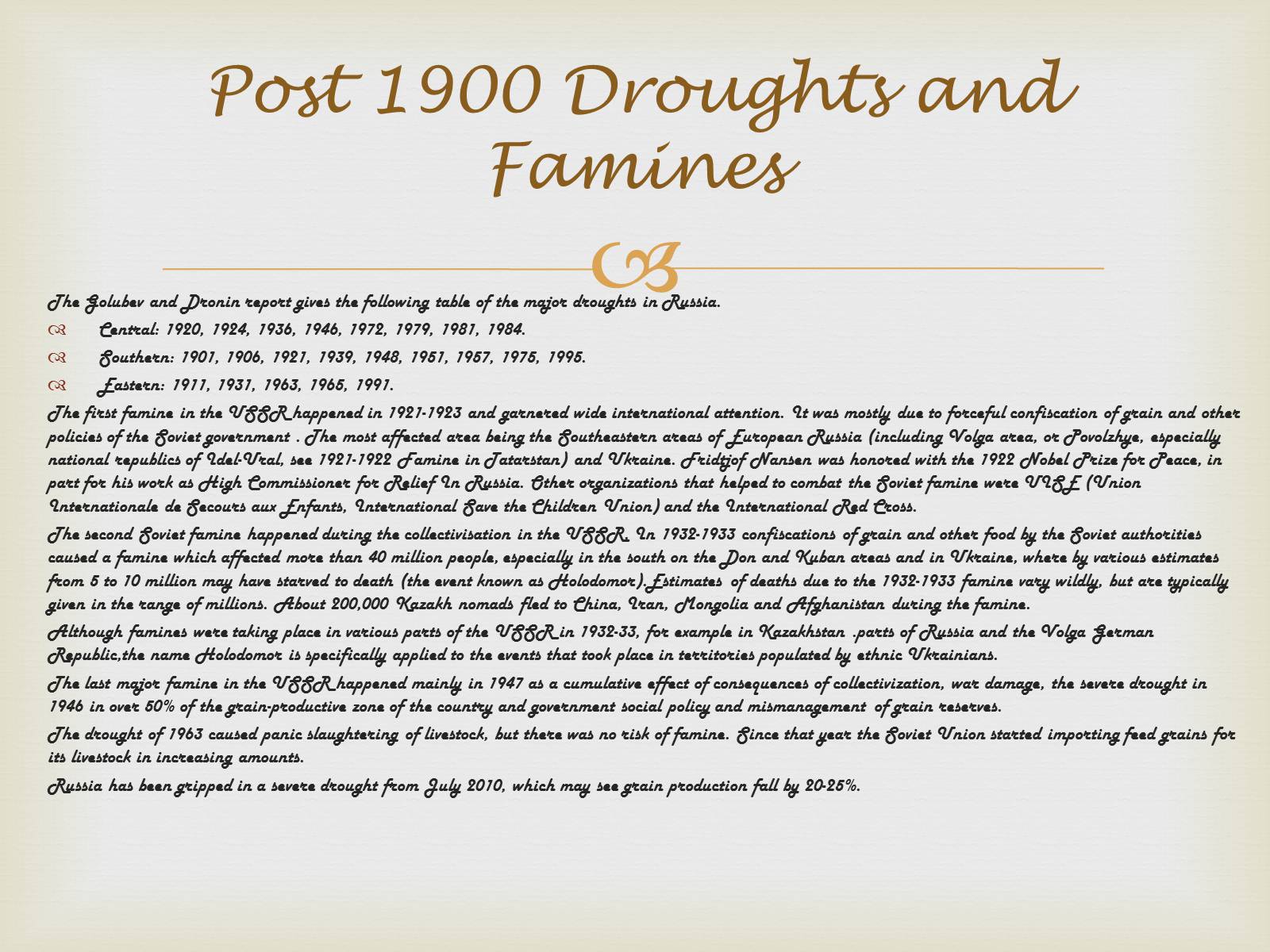- Головна
- Готові шкільні презентації
- Презентація на тему «Drought And Famine»
Презентація на тему «Drought And Famine»
257
Слайд #1
Drought And Famine
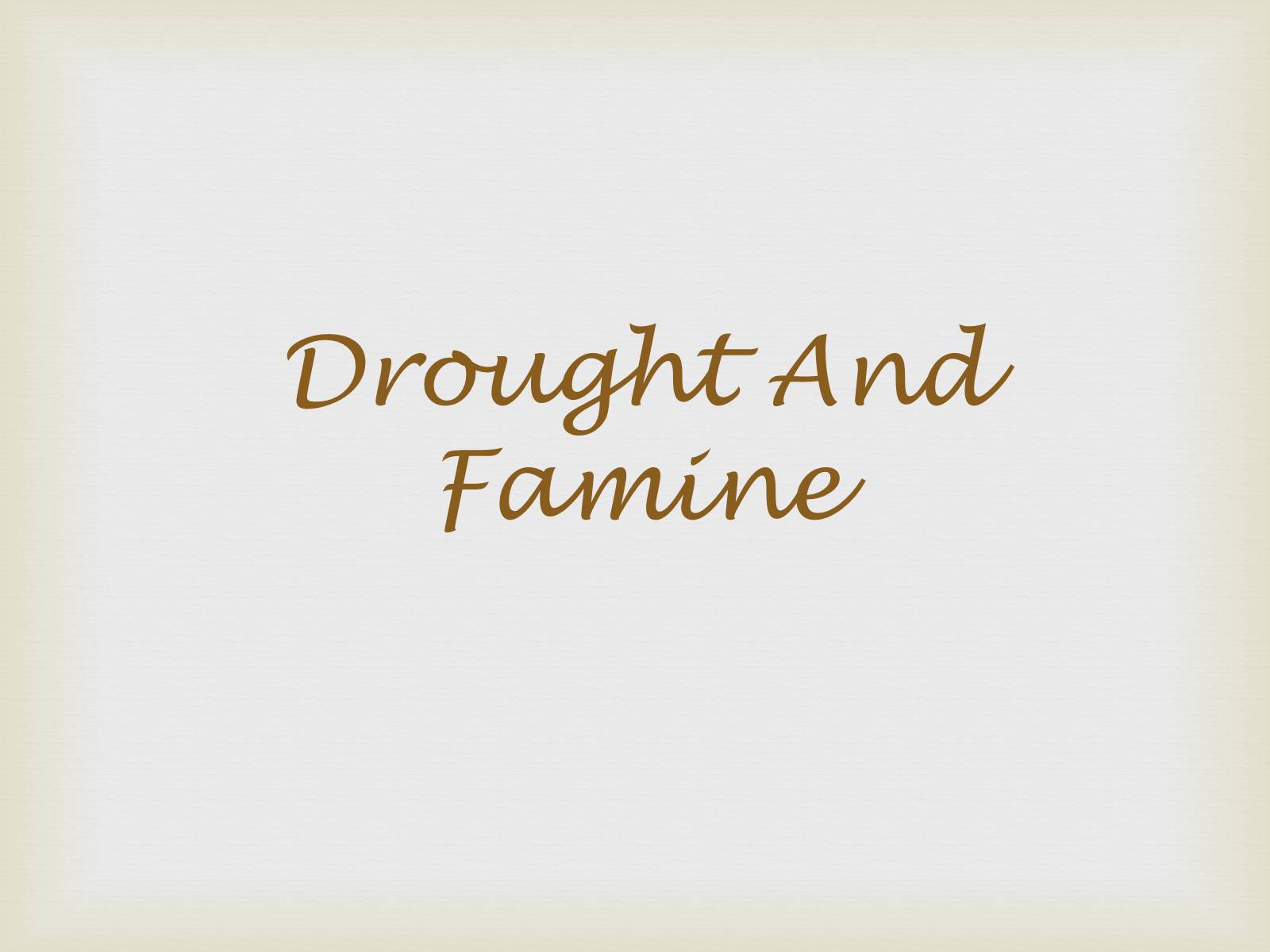
Слайд #2
Drought
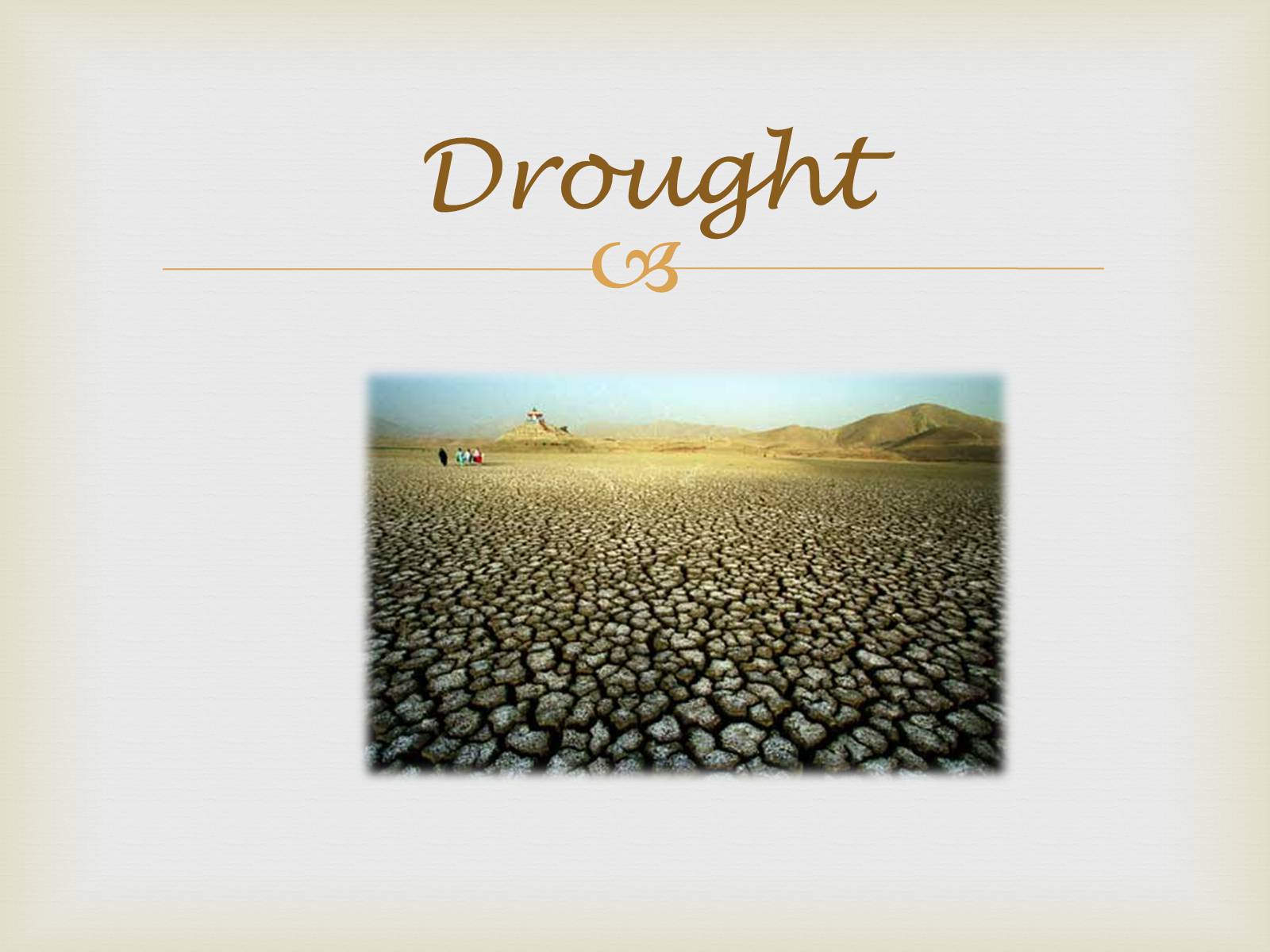
Слайд #3
Drought is an extended period of months or years when a region notes a deficiency in its water supply whether surface or underground water. Generally, this occurs when a region receives consistently below average precipitation. It can have a substantial impact on the ecosystem and agriculture of the affected region. Although droughts can persist for several years, even a short, intense drought can cause significant damage and harm the local economy.
Succulent plants are well-adapted to survive long periods of drought.
Many plant species, such as cacti, have adaptations such as reduced leaf area and waxy cuticles to enhance their ability to tolerate drought. Some others survive dry periods as buried seeds. Semi-permanent drought produces arid biomes such as deserts and grasslands. Most arid ecosystems have inherently low productivity.
This global phenomenon has a widespread impact on agriculture. Lengthy periods of drought have long been a key trigger for mass migration and played a key role in a number of ongoing migrations and other humanitarian crises in the Horn of Africa and the Sahel.
Succulent plants are well-adapted to survive long periods of drought.
Many plant species, such as cacti, have adaptations such as reduced leaf area and waxy cuticles to enhance their ability to tolerate drought. Some others survive dry periods as buried seeds. Semi-permanent drought produces arid biomes such as deserts and grasslands. Most arid ecosystems have inherently low productivity.
This global phenomenon has a widespread impact on agriculture. Lengthy periods of drought have long been a key trigger for mass migration and played a key role in a number of ongoing migrations and other humanitarian crises in the Horn of Africa and the Sahel.
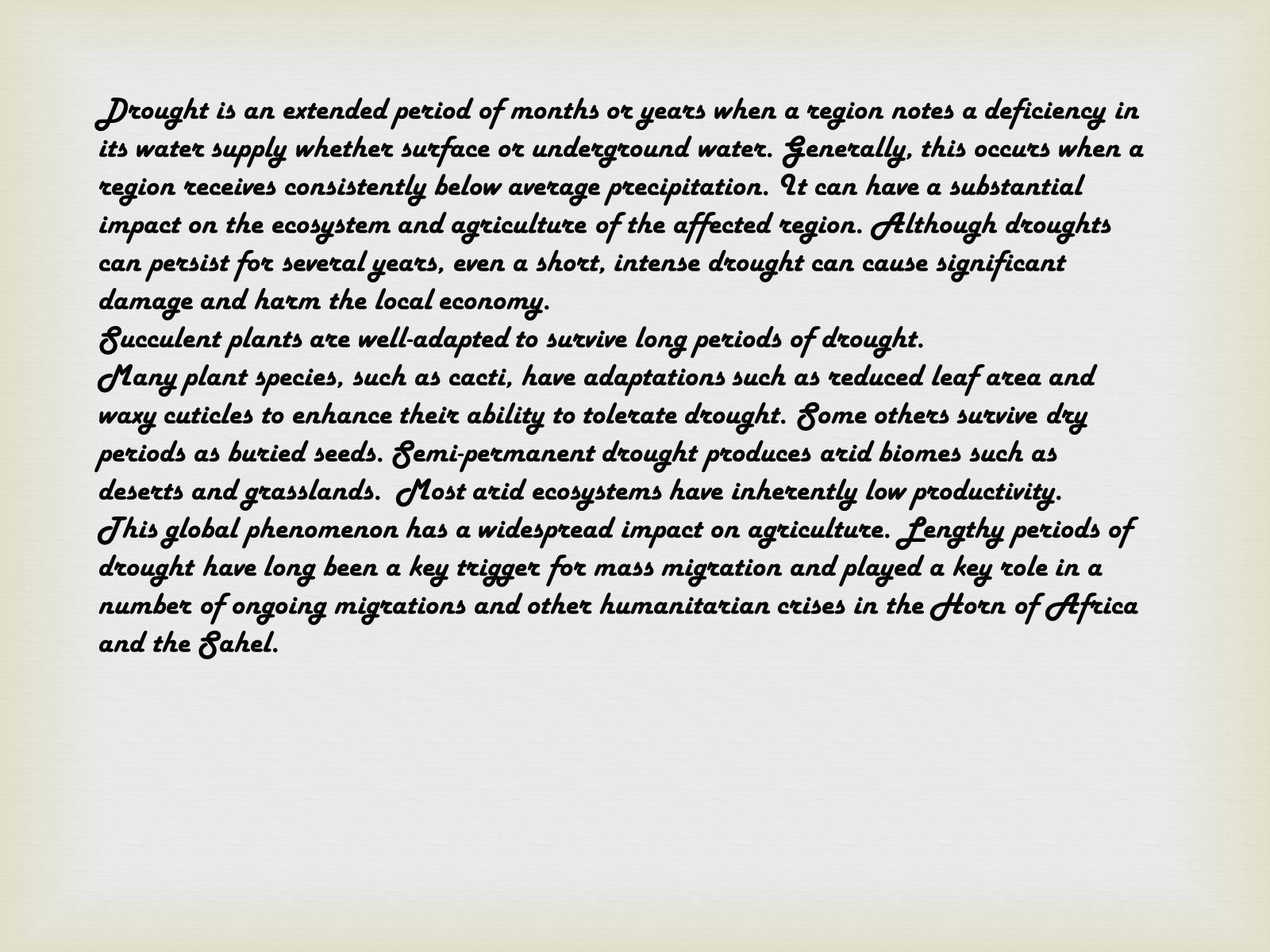
Слайд #4
Consequences
Periods of droughts can have significant environmental, agricultural, health, economic and social consequences. The effect varies according to vulnerability. For example, subsistence farmers are more likely to migrate during drought because they do not have alternative food sources. Areas with populations that depend on as a major food source are more vulnerable to drought-triggered famine.
Drought can also reduce water quality, because lower water flows reduce dilution of pollutants and increase contamination of remaining water sources. Common consequences of drought include:
Diminished crop growth or yield productions and carrying capacity for livestock
Dust bowls, themselves a sign of erosion, which further erode the landscape
Dust storms, when drought hits an area suffering from desertification and erosion
Famine due to lack of water for irrigation
Habitat damage, affecting both terrestrial and aquatic wildlife
Hunger, drought provides too little water to support food crops.
Malnutrition, dehydration and related diseases
Mass migration, resulting in internal displacement and international refugees
Reduced electricity production due to reduced water flow through hydroelectric dams
Shortages of water for industrial users
Snake migration and increases in snakebites
Social unrest
War over natural resources, including water and food
Wildfires, such as Australian bushfires, are more common during times of drought.
Periods of droughts can have significant environmental, agricultural, health, economic and social consequences. The effect varies according to vulnerability. For example, subsistence farmers are more likely to migrate during drought because they do not have alternative food sources. Areas with populations that depend on as a major food source are more vulnerable to drought-triggered famine.
Drought can also reduce water quality, because lower water flows reduce dilution of pollutants and increase contamination of remaining water sources. Common consequences of drought include:
Diminished crop growth or yield productions and carrying capacity for livestock
Dust bowls, themselves a sign of erosion, which further erode the landscape
Dust storms, when drought hits an area suffering from desertification and erosion
Famine due to lack of water for irrigation
Habitat damage, affecting both terrestrial and aquatic wildlife
Hunger, drought provides too little water to support food crops.
Malnutrition, dehydration and related diseases
Mass migration, resulting in internal displacement and international refugees
Reduced electricity production due to reduced water flow through hydroelectric dams
Shortages of water for industrial users
Snake migration and increases in snakebites
Social unrest
War over natural resources, including water and food
Wildfires, such as Australian bushfires, are more common during times of drought.
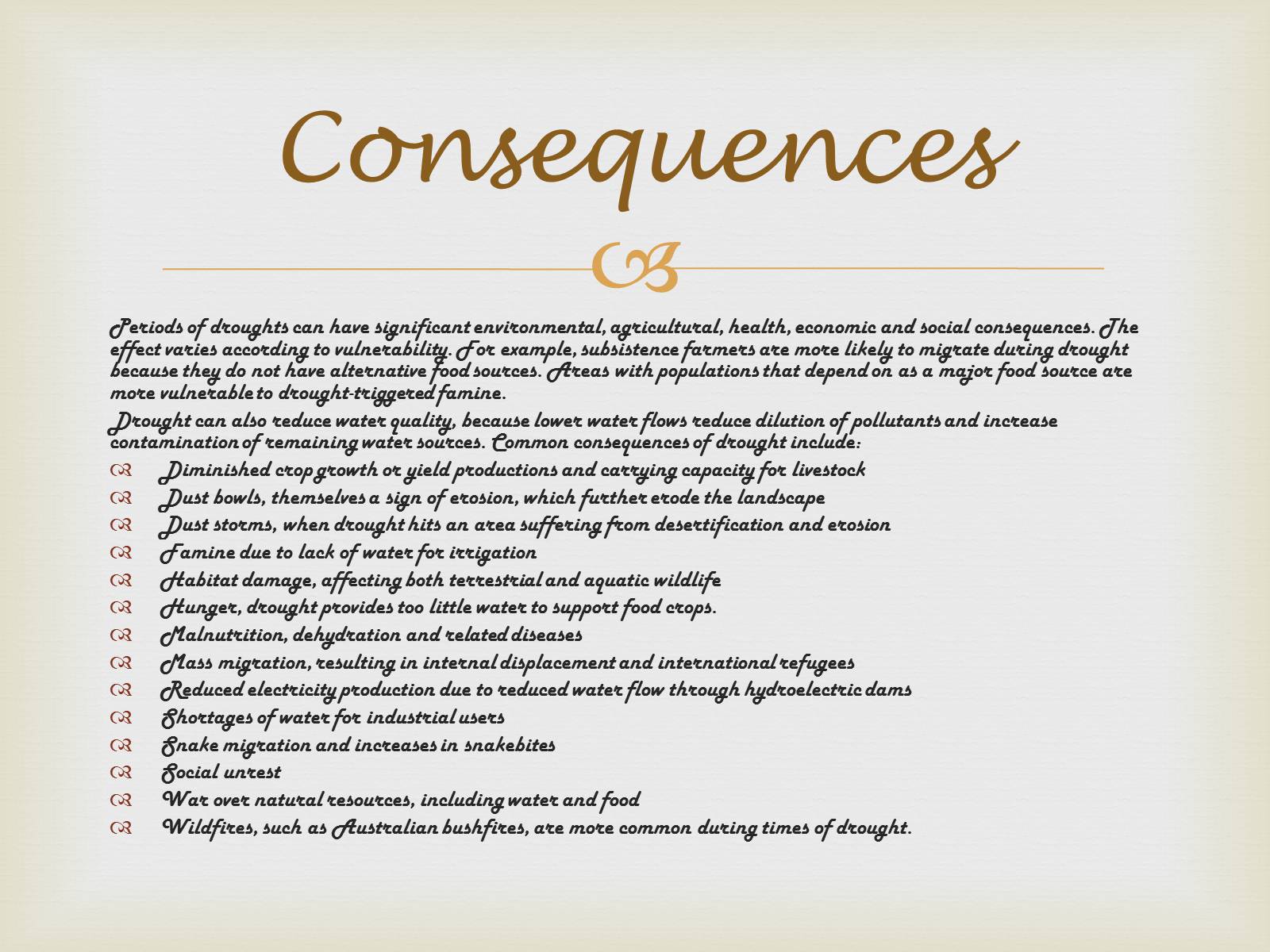
Слайд #5
Drought is a normal, recurring feature of the climate in most parts of the world. It is among the earliest documented climatic events, present in the Epic of Gilgamesh and tied to the biblical story of Joseph's arrival in and the later Exodus from Ancient Egypt.Hunter-gatherer migrations in 9,500 BC Chile have been linked to the phenomenon, as has the exodus of early humans out of Africa and into the rest of the world around 135,000 years ago.
Modern people can effectively mitigate much of the impact of drought through irrigation and crop rotation. Failure to develop adequate drought mitigation strategies carries a grave human cost in the modern era, exacerbated by ever-increasing population densities.
Globally
Modern people can effectively mitigate much of the impact of drought through irrigation and crop rotation. Failure to develop adequate drought mitigation strategies carries a grave human cost in the modern era, exacerbated by ever-increasing population densities.
Globally
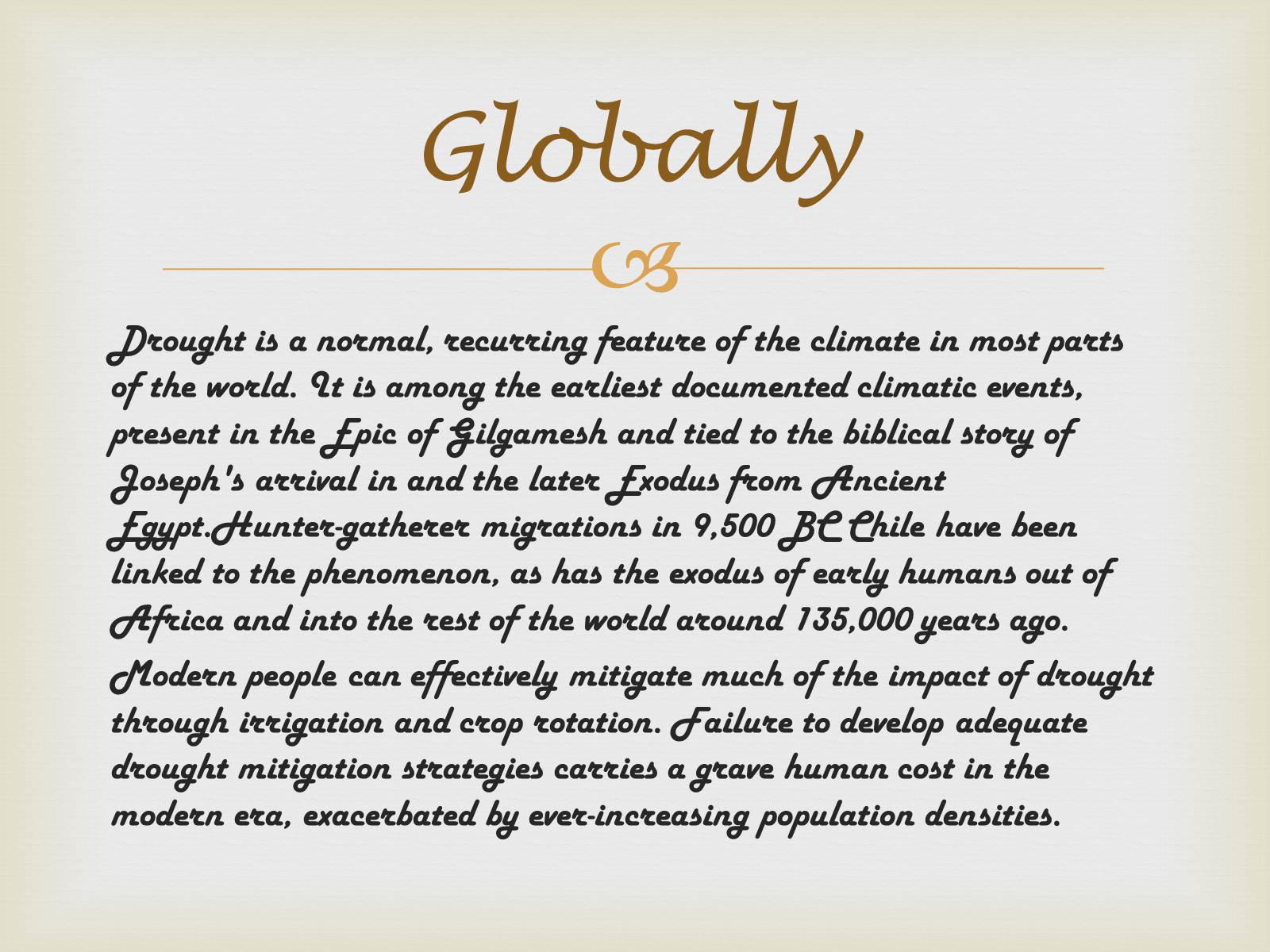
Слайд #6
Regions
Recurring droughts leading to desertification in the Horn of Africa have created grave ecological catastrophes, prompting massive food shortages, still recurring.To the north-west of the Horn, the Darfur conflict in neighboring Sudan, also affecting Chad, was fueled by decades of drought; combination of drought, desertification and overpopulation are among the causes of the Darfur conflict, because the Arab Baggara nomads searching for water have to take their livestock further south, to land mainly occupied by non-Arab farming peoples.Approximately 2.4 billion people live in the drainage basin of the Himalayan rivers.India, China, Pakistan, Bangladesh, Nepal and Myanmar could experience floods followed by droughts in coming decades. Drought in India affecting the Ganges is of particular concern, as it provides drinking water and agricultural irrigation for more than 500 million people.The west coast of North America, which gets much of its water from glaciers in mountain ranges such as the Rocky Mountains and Sierra Nevada, also would be affected.
Recurring droughts leading to desertification in the Horn of Africa have created grave ecological catastrophes, prompting massive food shortages, still recurring.To the north-west of the Horn, the Darfur conflict in neighboring Sudan, also affecting Chad, was fueled by decades of drought; combination of drought, desertification and overpopulation are among the causes of the Darfur conflict, because the Arab Baggara nomads searching for water have to take their livestock further south, to land mainly occupied by non-Arab farming peoples.Approximately 2.4 billion people live in the drainage basin of the Himalayan rivers.India, China, Pakistan, Bangladesh, Nepal and Myanmar could experience floods followed by droughts in coming decades. Drought in India affecting the Ganges is of particular concern, as it provides drinking water and agricultural irrigation for more than 500 million people.The west coast of North America, which gets much of its water from glaciers in mountain ranges such as the Rocky Mountains and Sierra Nevada, also would be affected.
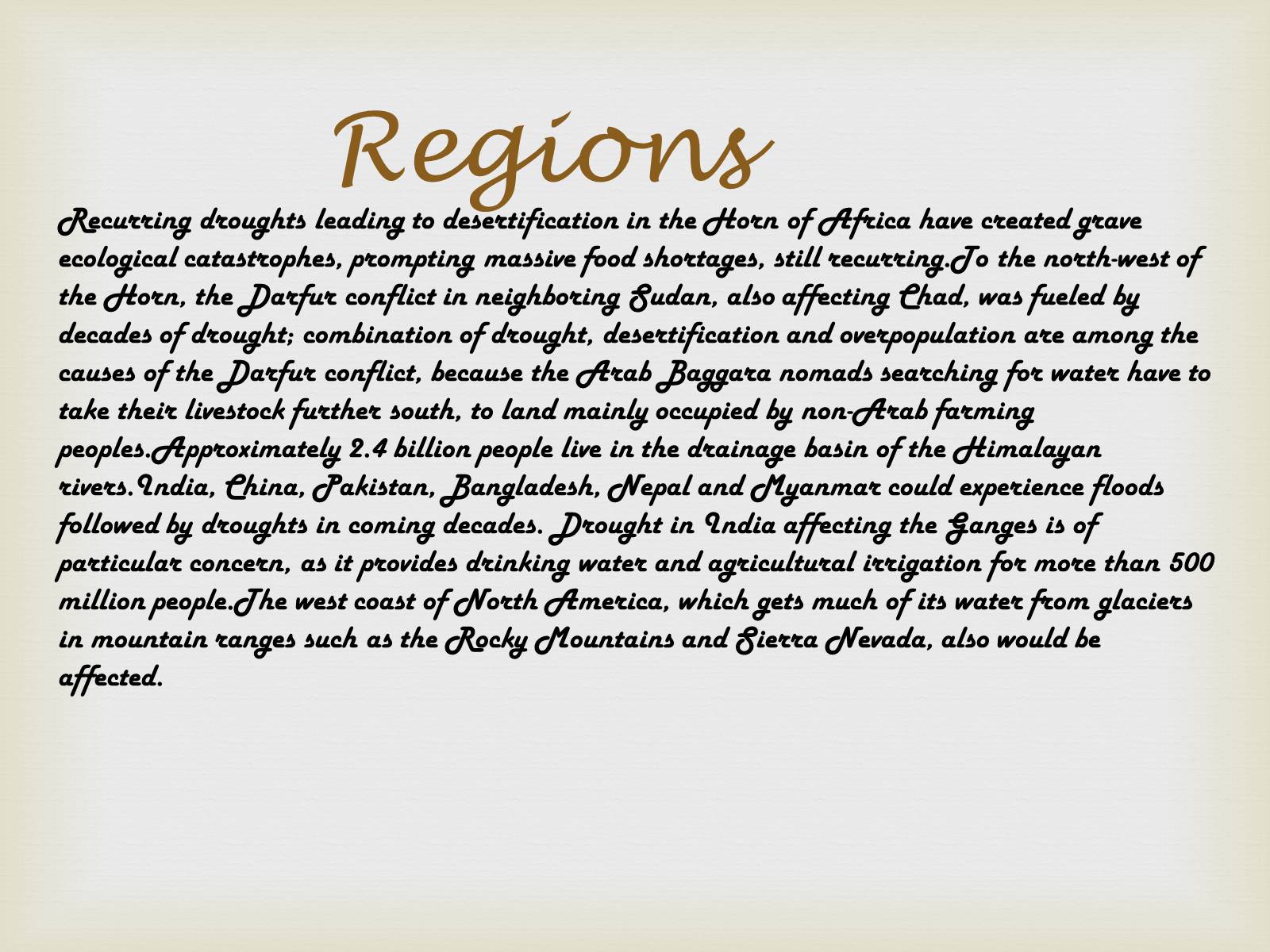
Слайд #7
In 2005, parts of the Amazon basin experienced the worst drought in 100 years.A 23 July 2006 article reported Woods Hole Research Center results showing that the forest in its present form could survive only three years of drought.Scientists at the Brazilian National Institute of Amazonian Research argue in the article that this drought response, coupled with the effects of deforestation on regional climate, are pushing the rainforest towards a "tipping point" where it would irreversibly start to die. It concludes that the rainforest is on the brink of being turned into savanna or desert, with catastrophic consequences for the world's climate. According to the WWF, the combination of climate change and deforestation increases the drying effect of dead trees that fuels forest fires.
By far the largest part of Australia is desert or semi-arid lands commonly known as the outback. A 2005 study by Australian and American researchers investigated the desertification of the interior, and suggested that one explanation was related to human settlers who arrived about 50,000 years ago. Regular burning by these settlers could have prevented monsoons from reaching interior Australia.In June 2008 it became known that an expert panel had warned of long term, maybe irreversible, severe ecological damage for the whole Murray-Darling basin if it does not receive sufficient water by October.Australia could experience more severe droughts and they could become more frequent in the future, a government-commissioned report said on July 6, 2008.Australian environmentalist Tim Flannery, predicted that unless it made drastic changes, Perth in Western Australia could become the world's first ghost metropolis, an abandoned city with no more water to sustain its population.East Africa currently faces its worst drought in decades,with crops and livestock destroyed. The U.N. World Food Programme recently said that nearly four million Kenyans urgently needed food.
By far the largest part of Australia is desert or semi-arid lands commonly known as the outback. A 2005 study by Australian and American researchers investigated the desertification of the interior, and suggested that one explanation was related to human settlers who arrived about 50,000 years ago. Regular burning by these settlers could have prevented monsoons from reaching interior Australia.In June 2008 it became known that an expert panel had warned of long term, maybe irreversible, severe ecological damage for the whole Murray-Darling basin if it does not receive sufficient water by October.Australia could experience more severe droughts and they could become more frequent in the future, a government-commissioned report said on July 6, 2008.Australian environmentalist Tim Flannery, predicted that unless it made drastic changes, Perth in Western Australia could become the world's first ghost metropolis, an abandoned city with no more water to sustain its population.East Africa currently faces its worst drought in decades,with crops and livestock destroyed. The U.N. World Food Programme recently said that nearly four million Kenyans urgently needed food.
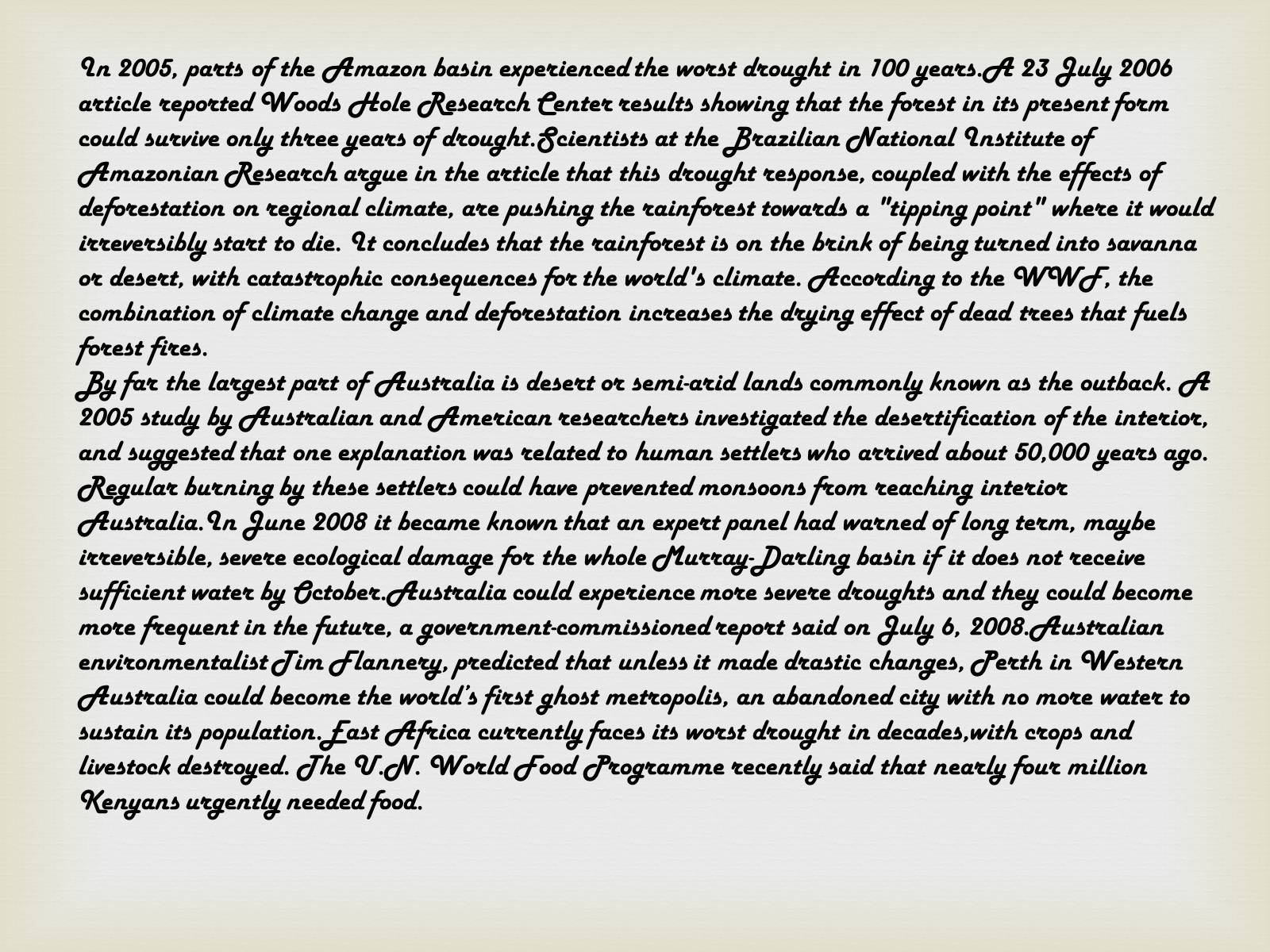
Слайд #8
In 2005, parts of the Amazon basin experienced the worst drought in 100 years.A 23 July 2006 article reported Woods Hole Research Center results showing that the forest in its present form could survive only three years of drought.Scientists at the Brazilian National Institute of Amazonian Research argue in the article that this drought response, coupled with the effects of deforestation on regional climate, are pushing the rainforest towards a "tipping point" where it would irreversibly start to die. It concludes that the rainforest is on the brink of being turned into savanna or desert, with catastrophic consequences for the world's climate. According to the WWF, the combination of climate change and deforestation increases the drying effect of dead trees that fuels forest fires.
By far the largest part of Australia is desert or semi-arid lands commonly known as the outback. A 2005 study by Australian and American researchers investigated the desertification of the interior, and suggested that one explanation was related to human settlers who arrived about 50,000 years ago. Regular burning by these settlers could have prevented monsoons from reaching interior Australia.In June 2008 it became known that an expert panel had warned of long term, maybe irreversible, severe ecological damage for the whole Murray-Darling basin if it does not receive sufficient water by October.Australia could experience more severe droughts and they could become more frequent in the future, a government-commissioned report said on July 6, 2008.Australian environmentalist Tim Flannery, predicted that unless it made drastic changes, Perth in Western Australia could become the world's first ghost metropolis, an abandoned city with no more water to sustain its population.East Africa currently faces its worst drought in decades,with crops and livestock destroyed. The U.N. World Food Programme recently said that nearly four million Kenyans urgently needed food.
By far the largest part of Australia is desert or semi-arid lands commonly known as the outback. A 2005 study by Australian and American researchers investigated the desertification of the interior, and suggested that one explanation was related to human settlers who arrived about 50,000 years ago. Regular burning by these settlers could have prevented monsoons from reaching interior Australia.In June 2008 it became known that an expert panel had warned of long term, maybe irreversible, severe ecological damage for the whole Murray-Darling basin if it does not receive sufficient water by October.Australia could experience more severe droughts and they could become more frequent in the future, a government-commissioned report said on July 6, 2008.Australian environmentalist Tim Flannery, predicted that unless it made drastic changes, Perth in Western Australia could become the world's first ghost metropolis, an abandoned city with no more water to sustain its population.East Africa currently faces its worst drought in decades,with crops and livestock destroyed. The U.N. World Food Programme recently said that nearly four million Kenyans urgently needed food.
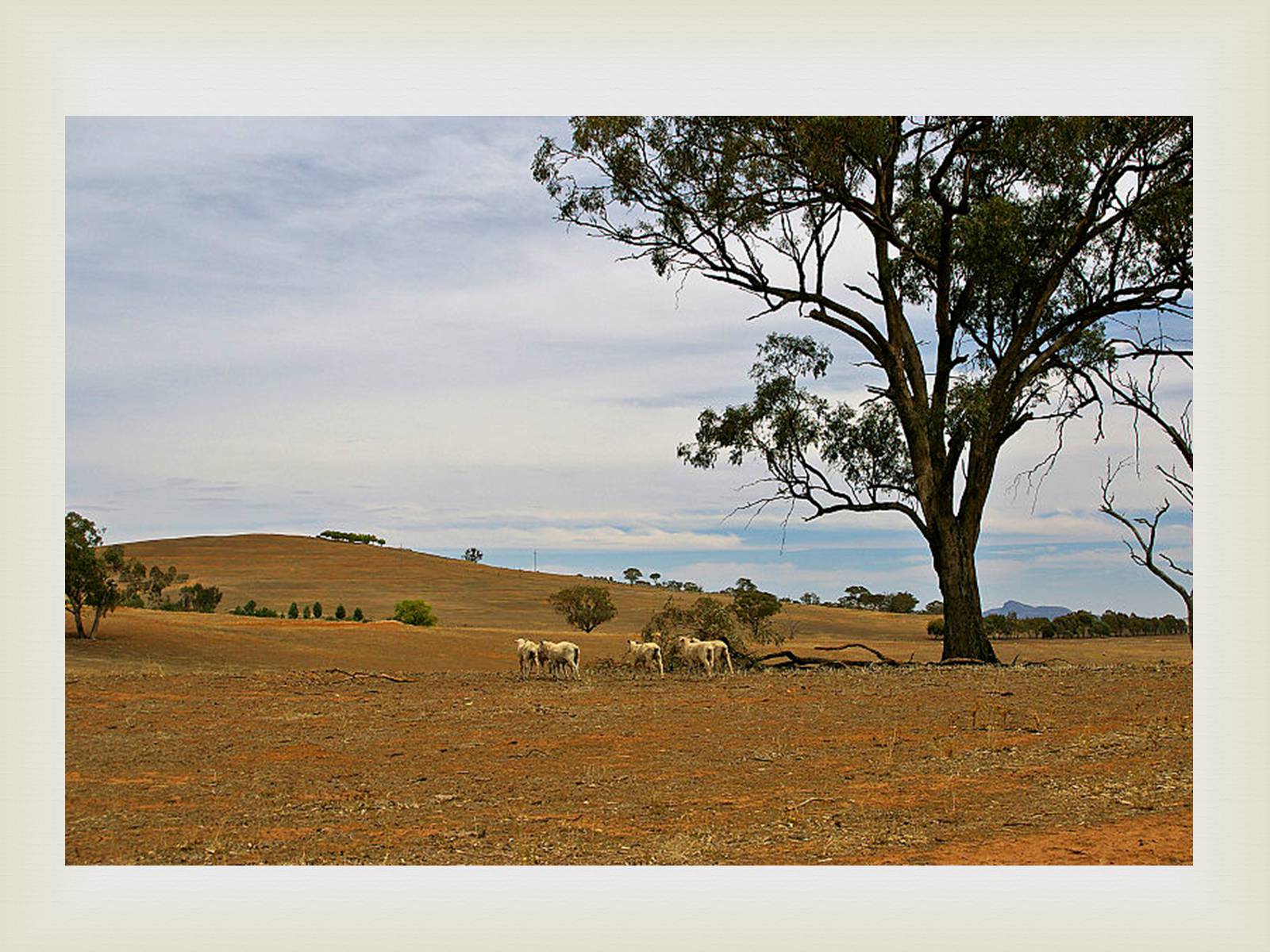
Слайд #9
Causes
Generally, rainfall is related to the amount and dew point [determined by air temperature] of water vapour carried by regional atmosphere, combined with the upward forcing of the air mass containing that water vapour. If these combined factors do not support precipitation volumes sufficient to reach the surface, the result is a drought. This can be triggered by high level of reflected sunlight, [high albedo], and above average prevalence of high pressure systems, winds carrying continental, rather than oceanic air masses (i.e. reduced water content), and ridges of high pressure areas from behaviors which prevent or restrict the developing of thunderstorm activity or rainfall over one certain region. Oceanic and atmospheric weather cycles such as the El Niño-Southern Oscillation (ENSO) make drought a regular recurring feature of the Americas along the Midwest and Australia. Guns, Germs, and Steel author Jared Diamond sees the stark impact of the multi-year ENSO cycles on Australian weather patterns as a key reason that Australian aborigines remained a hunter-gatherer society rather than adopting agriculture.Another climate oscillation known as the North Atlantic Oscillation has been tied to droughts in northeast Spain.Human activity can directly trigger exacerbating factors such as over farming, excessive irrigation, deforestation, and erosion adversely impact the ability of the land to capture and hold water.While these tend to be relatively isolated in their scope, activities resulting in global climate change are expected to trigger droughts with a substantial impact on agriculture throughout the world, and especially in developing nations.Overall, global warming will result in increased world rainfall . Along with drought in some areas, flooding and erosion will increase in others. Paradoxically, some proposed solutions to global warming that focus on more active techniques, solar radiation management through the use of a space sunshade for one, may also carry with them increased chances of drought.
Generally, rainfall is related to the amount and dew point [determined by air temperature] of water vapour carried by regional atmosphere, combined with the upward forcing of the air mass containing that water vapour. If these combined factors do not support precipitation volumes sufficient to reach the surface, the result is a drought. This can be triggered by high level of reflected sunlight, [high albedo], and above average prevalence of high pressure systems, winds carrying continental, rather than oceanic air masses (i.e. reduced water content), and ridges of high pressure areas from behaviors which prevent or restrict the developing of thunderstorm activity or rainfall over one certain region. Oceanic and atmospheric weather cycles such as the El Niño-Southern Oscillation (ENSO) make drought a regular recurring feature of the Americas along the Midwest and Australia. Guns, Germs, and Steel author Jared Diamond sees the stark impact of the multi-year ENSO cycles on Australian weather patterns as a key reason that Australian aborigines remained a hunter-gatherer society rather than adopting agriculture.Another climate oscillation known as the North Atlantic Oscillation has been tied to droughts in northeast Spain.Human activity can directly trigger exacerbating factors such as over farming, excessive irrigation, deforestation, and erosion adversely impact the ability of the land to capture and hold water.While these tend to be relatively isolated in their scope, activities resulting in global climate change are expected to trigger droughts with a substantial impact on agriculture throughout the world, and especially in developing nations.Overall, global warming will result in increased world rainfall . Along with drought in some areas, flooding and erosion will increase in others. Paradoxically, some proposed solutions to global warming that focus on more active techniques, solar radiation management through the use of a space sunshade for one, may also carry with them increased chances of drought.
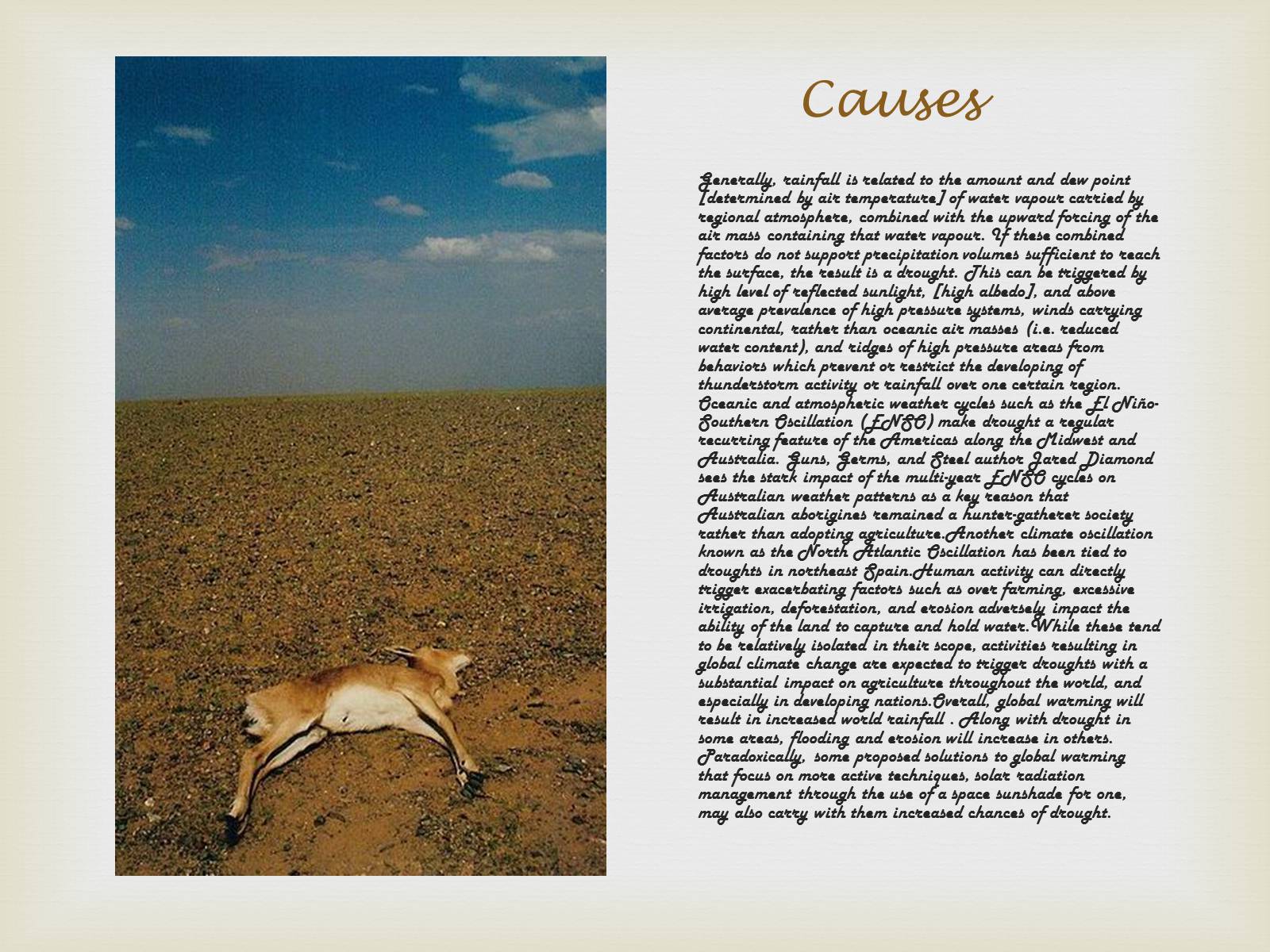
Слайд #10
Types
As a drought persists, the conditions surrounding it gradually worsen and its impact on the local population gradually increases. People tend to define droughts in three main ways:Meteorological drought is brought about when there is a prolonged period with less than average precipitation. Meteorological drought usually precedes the other kinds of drought.
Agricultural droughts are droughts that affect crop production or the ecology of the range. This condition can also arise independently from any change in precipitation levels when soil conditions and erosion triggered by poorly planned agricultural endeavors cause a shortfall in water available to the crops. However, in a traditional drought, it is caused by an extended period of below average precipitation.
Hydrological drought is brought about when the water reserves available in sources such as aquifers, lakes and reservoirs fall below the statistical average. Hydrological drought tends to show up more slowly because it involves stored water that is used but not replenished. Like an agricultural drought, this can be triggered by more than just a loss of rainfall. For instance, Kazakhstan was recently awarded a large amount of money by the World Bank to restore water that had been diverted to other nations from the Aral Sea under Soviet rule.Similar circumstances also place their largest lake, Balkhash, at risk of completely drying out.
As a drought persists, the conditions surrounding it gradually worsen and its impact on the local population gradually increases. People tend to define droughts in three main ways:Meteorological drought is brought about when there is a prolonged period with less than average precipitation. Meteorological drought usually precedes the other kinds of drought.
Agricultural droughts are droughts that affect crop production or the ecology of the range. This condition can also arise independently from any change in precipitation levels when soil conditions and erosion triggered by poorly planned agricultural endeavors cause a shortfall in water available to the crops. However, in a traditional drought, it is caused by an extended period of below average precipitation.
Hydrological drought is brought about when the water reserves available in sources such as aquifers, lakes and reservoirs fall below the statistical average. Hydrological drought tends to show up more slowly because it involves stored water that is used but not replenished. Like an agricultural drought, this can be triggered by more than just a loss of rainfall. For instance, Kazakhstan was recently awarded a large amount of money by the World Bank to restore water that had been diverted to other nations from the Aral Sea under Soviet rule.Similar circumstances also place their largest lake, Balkhash, at risk of completely drying out.
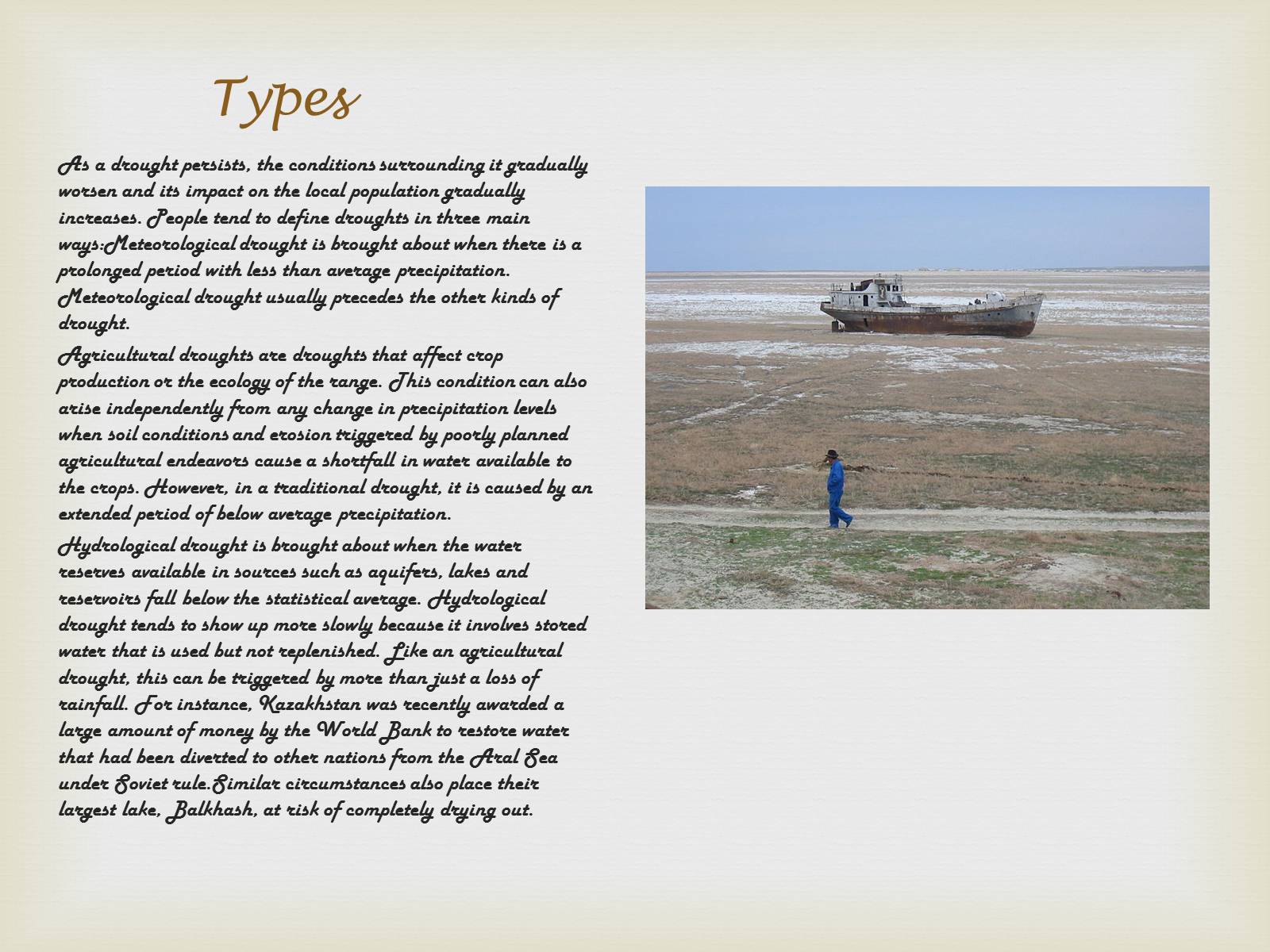
Слайд #11
Protection and relief
Dams - many dams and their associated reservoirs supply additional water in times of drought.
Dams - many dams and their associated reservoirs supply additional water in times of drought.
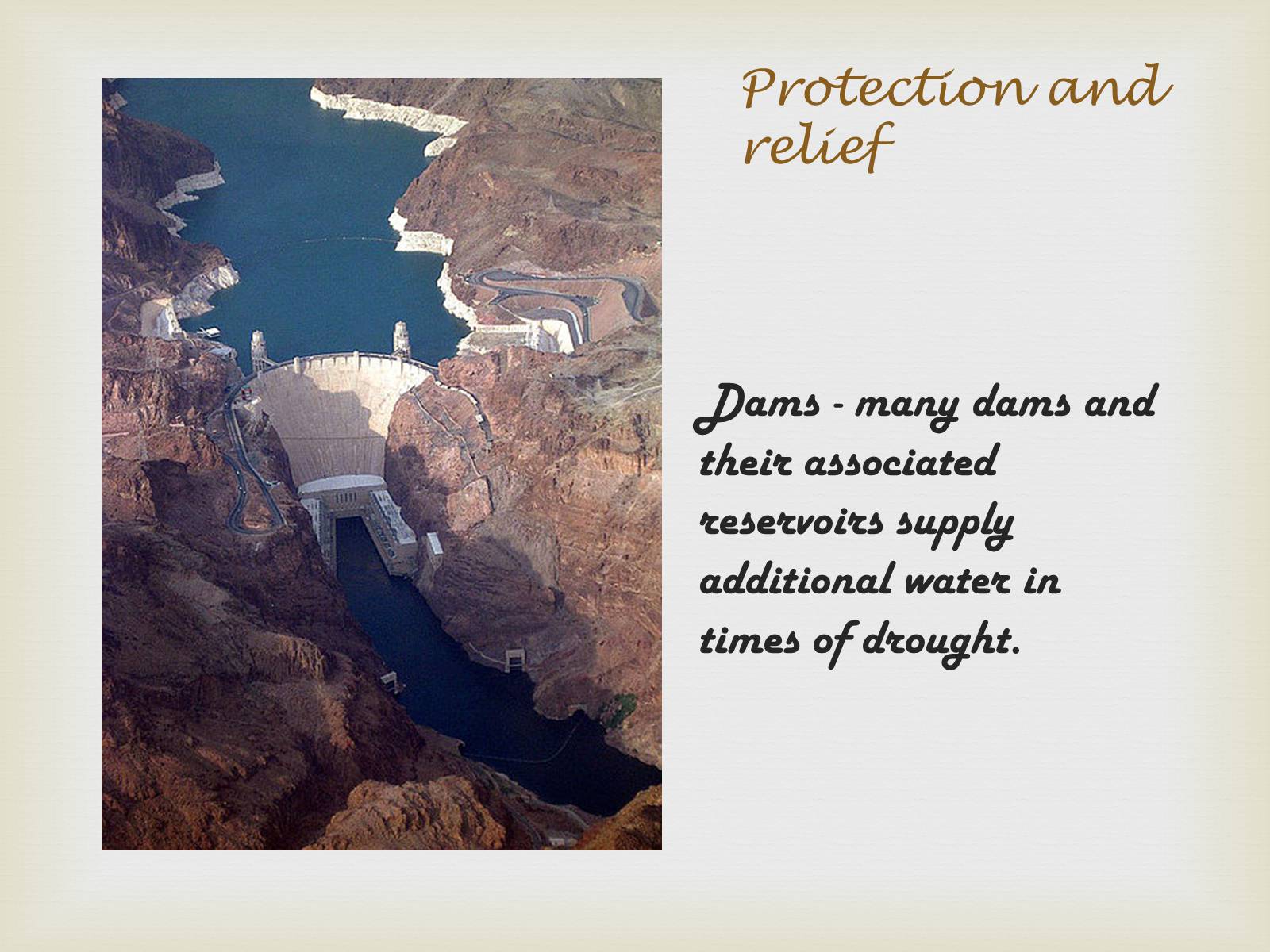
Слайд #12
Desalination of sea water for irrigation or consumption.
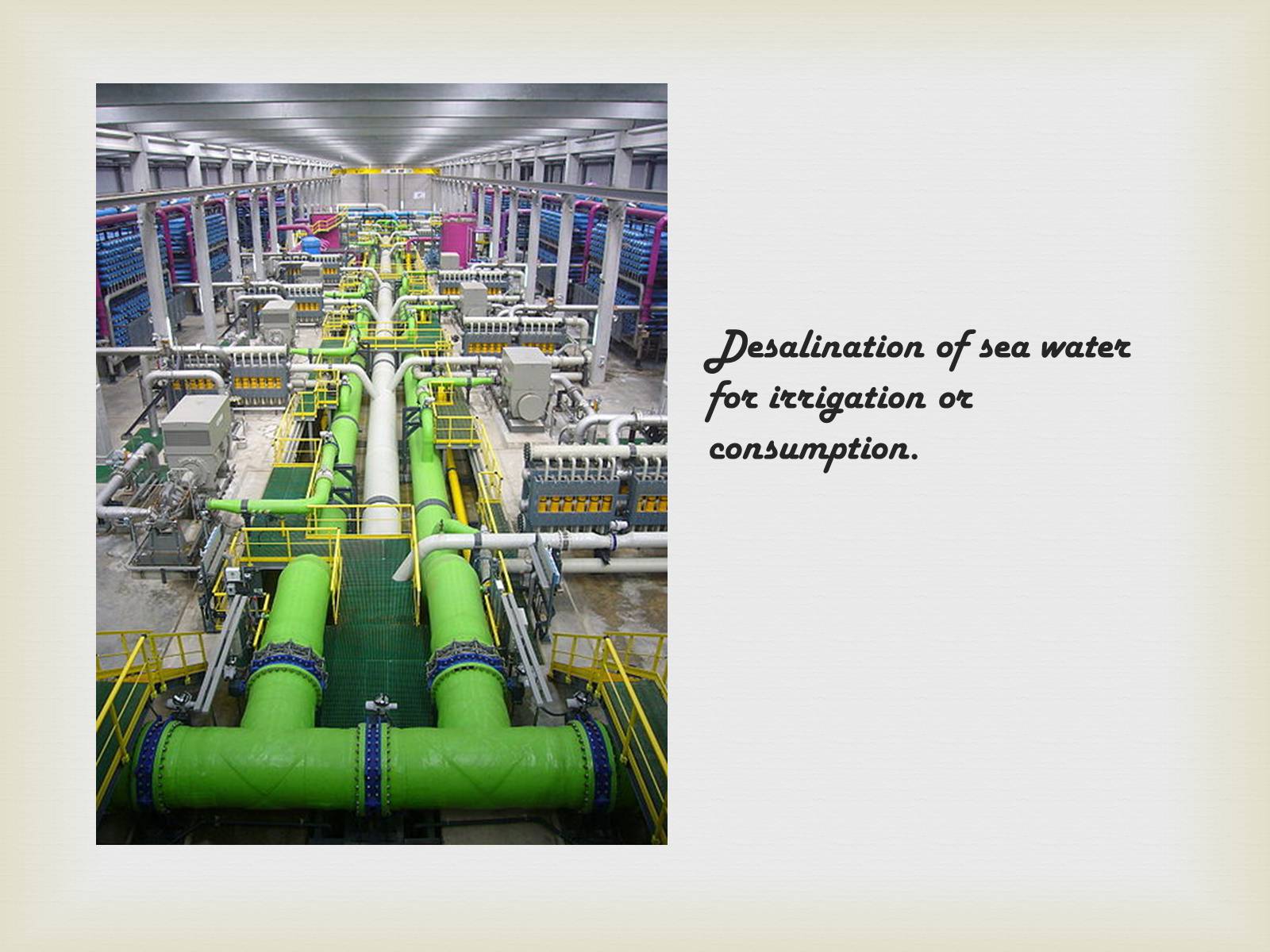
Слайд #13
Drought monitoring
Continuous observation of rainfall levels and comparisons with current usage levels can help prevent man-made drought. For instance, analysis of water usage in Yemen has revealed that their water table (underground water level) is put at grave risk by over-use to fertilize their Khat crop. Careful monitoring of moisture levels can also help predict increased risk for wildfires, using such metrics as the Keetch-Byram Drought Index or Palmer Drought Index.
Continuous observation of rainfall levels and comparisons with current usage levels can help prevent man-made drought. For instance, analysis of water usage in Yemen has revealed that their water table (underground water level) is put at grave risk by over-use to fertilize their Khat crop. Careful monitoring of moisture levels can also help predict increased risk for wildfires, using such metrics as the Keetch-Byram Drought Index or Palmer Drought Index.
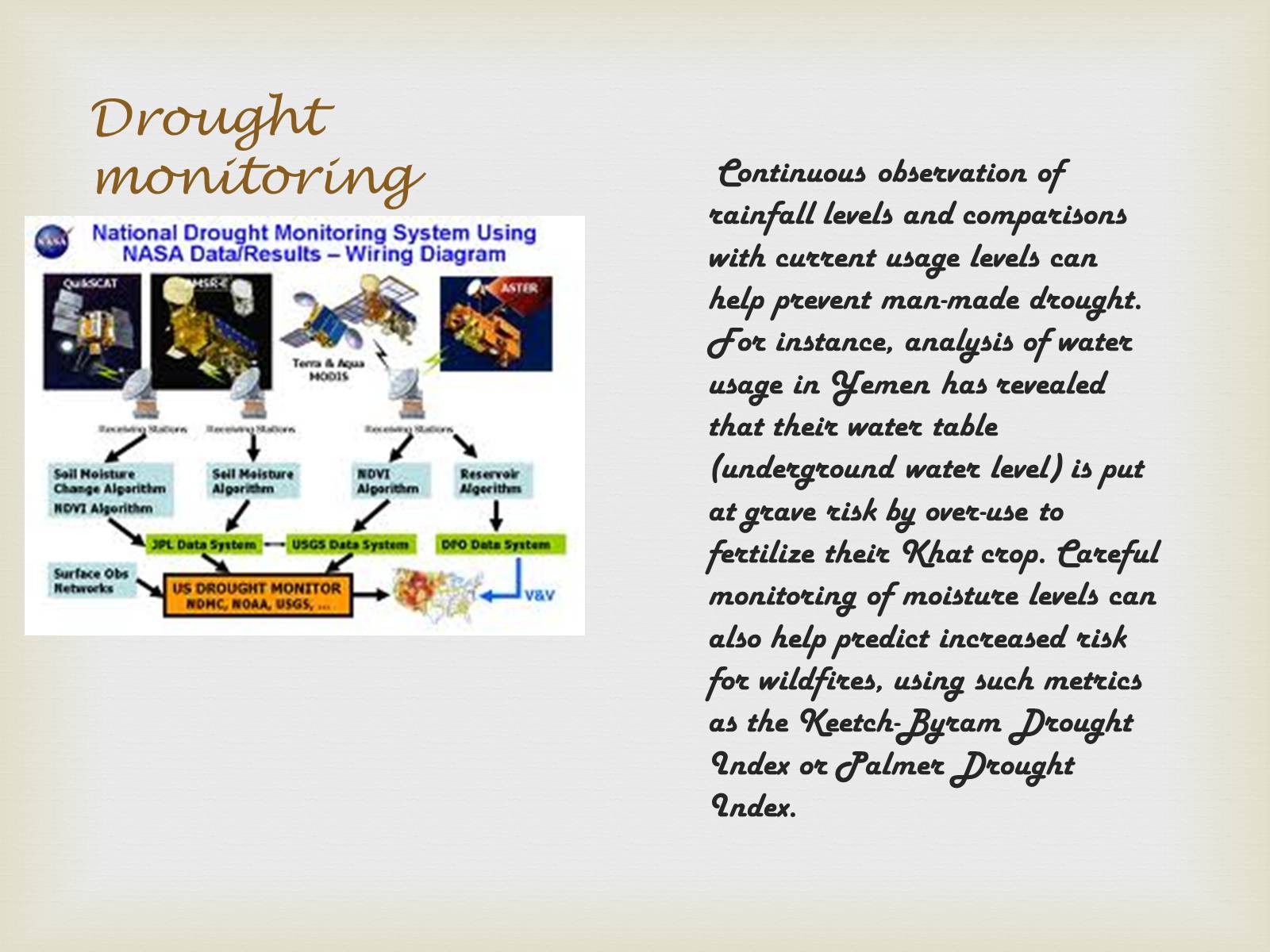
Слайд #14
Cloud seeding - an artificial technique to induce rainfall.
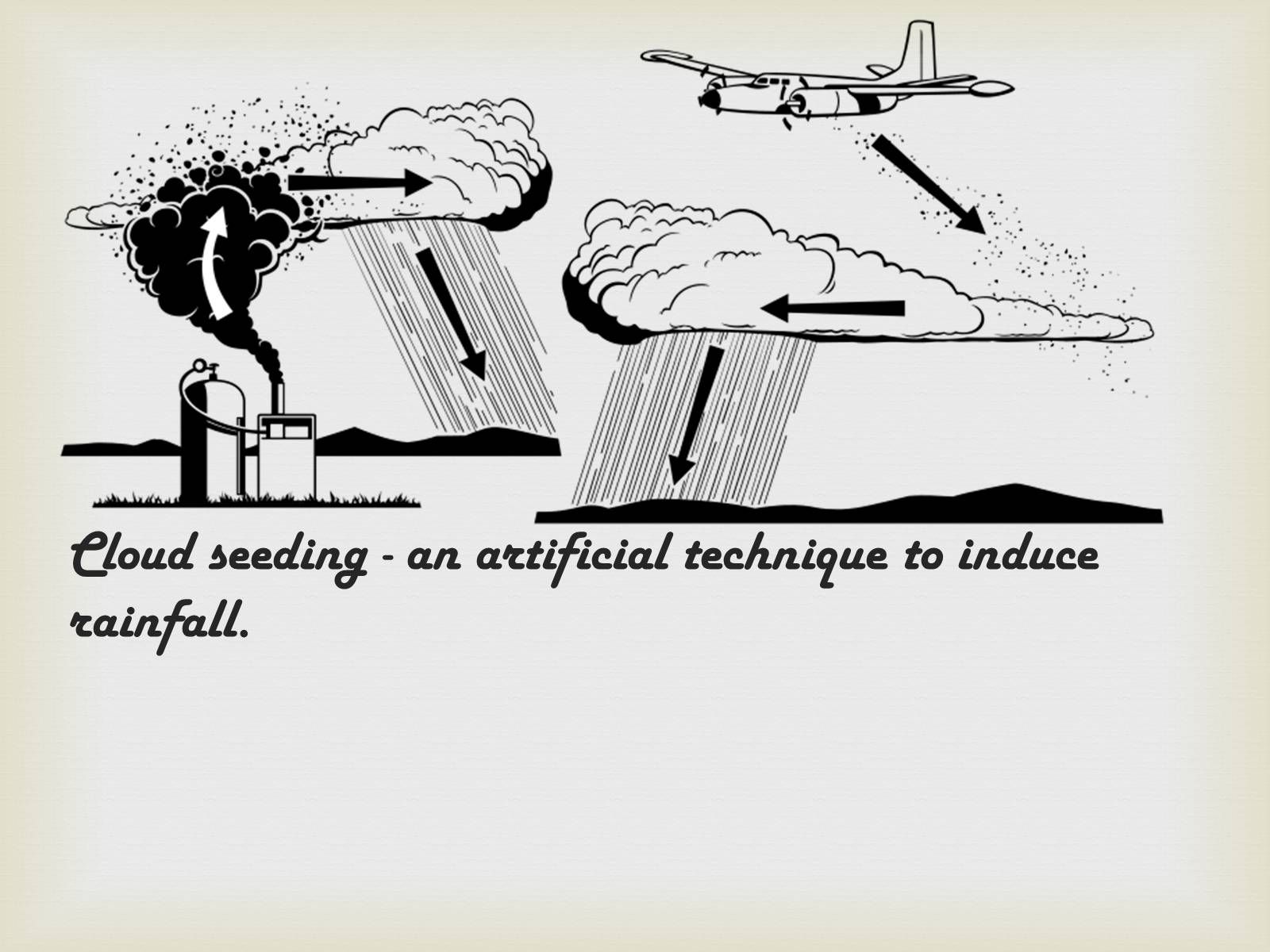
Слайд #15
Land use - Carefully planned crop rotation can help to minimize erosion and allow farmers to plant less water-dependent crops in drier years.
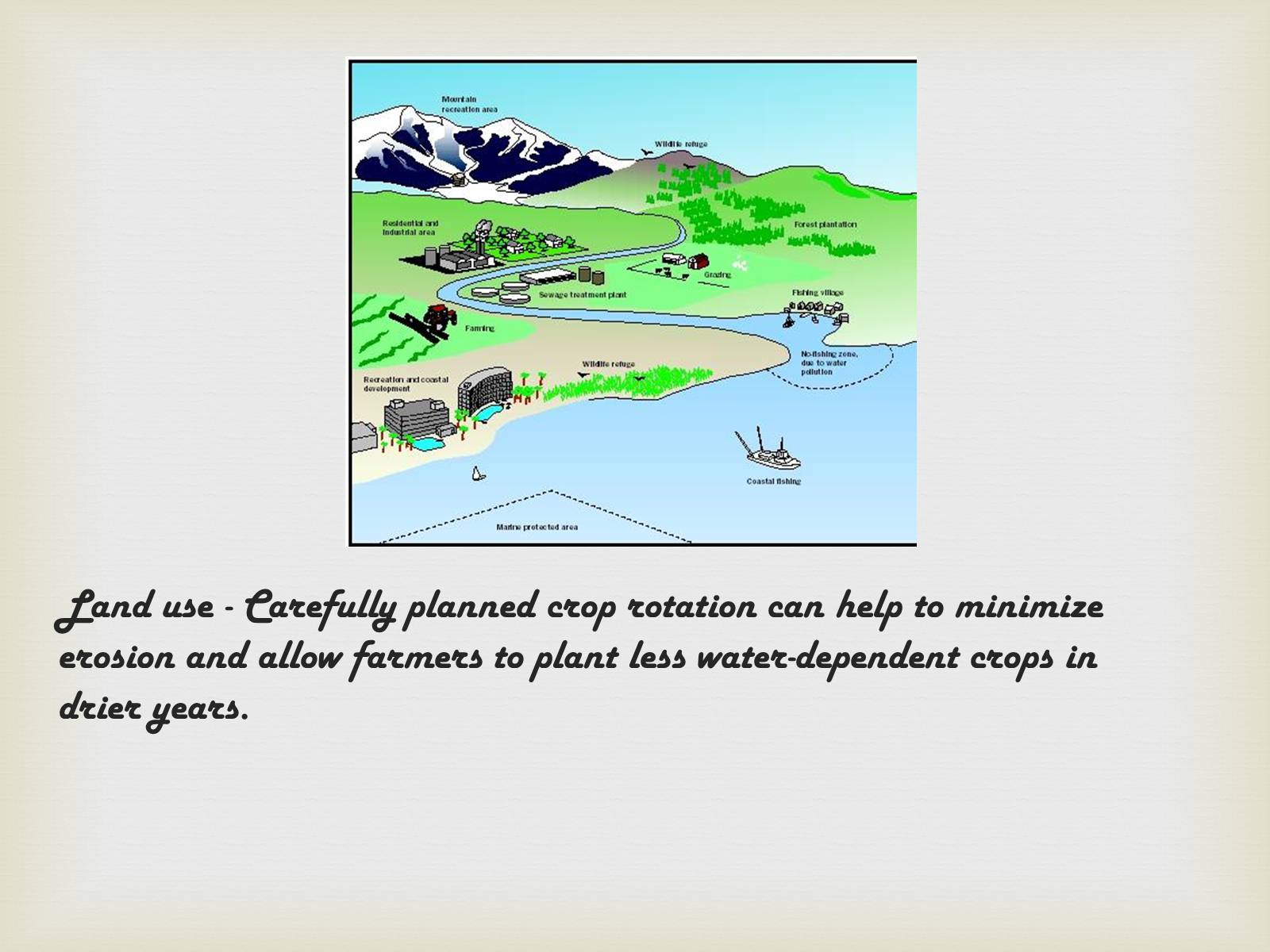
Слайд #16
Outdoor water-use restriction - Regulating the use of sprinklers, hoses or buckets on outdoor plants, filling pools, and other water-intensive home maintenance tasks.
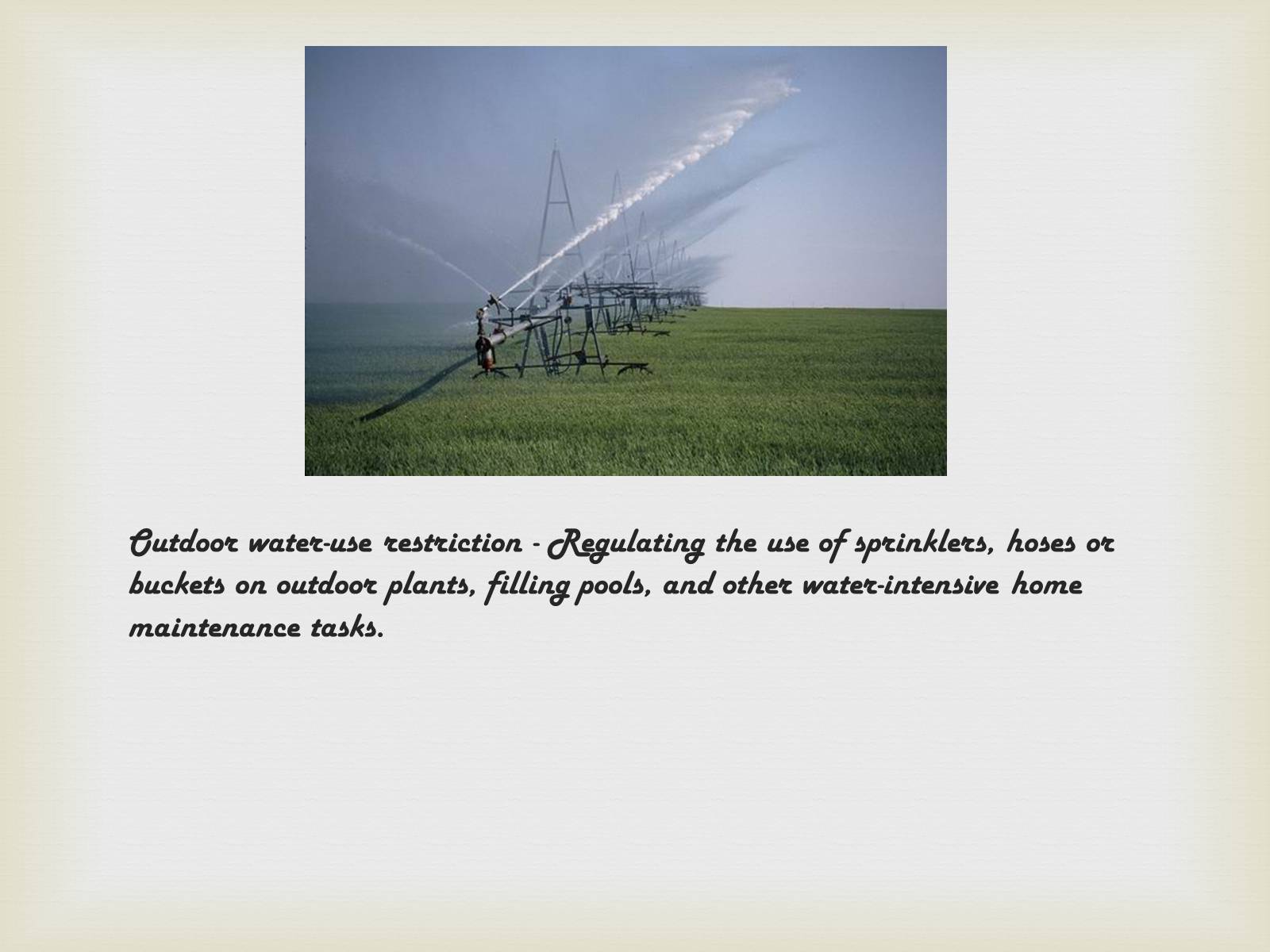
Слайд #17
Outdoor water-use restriction - Regulating the use of sprinklers, hoses or buckets on outdoor plants, filling pools, and other water-intensive home maintenance tasks.

Слайд #18
Famine
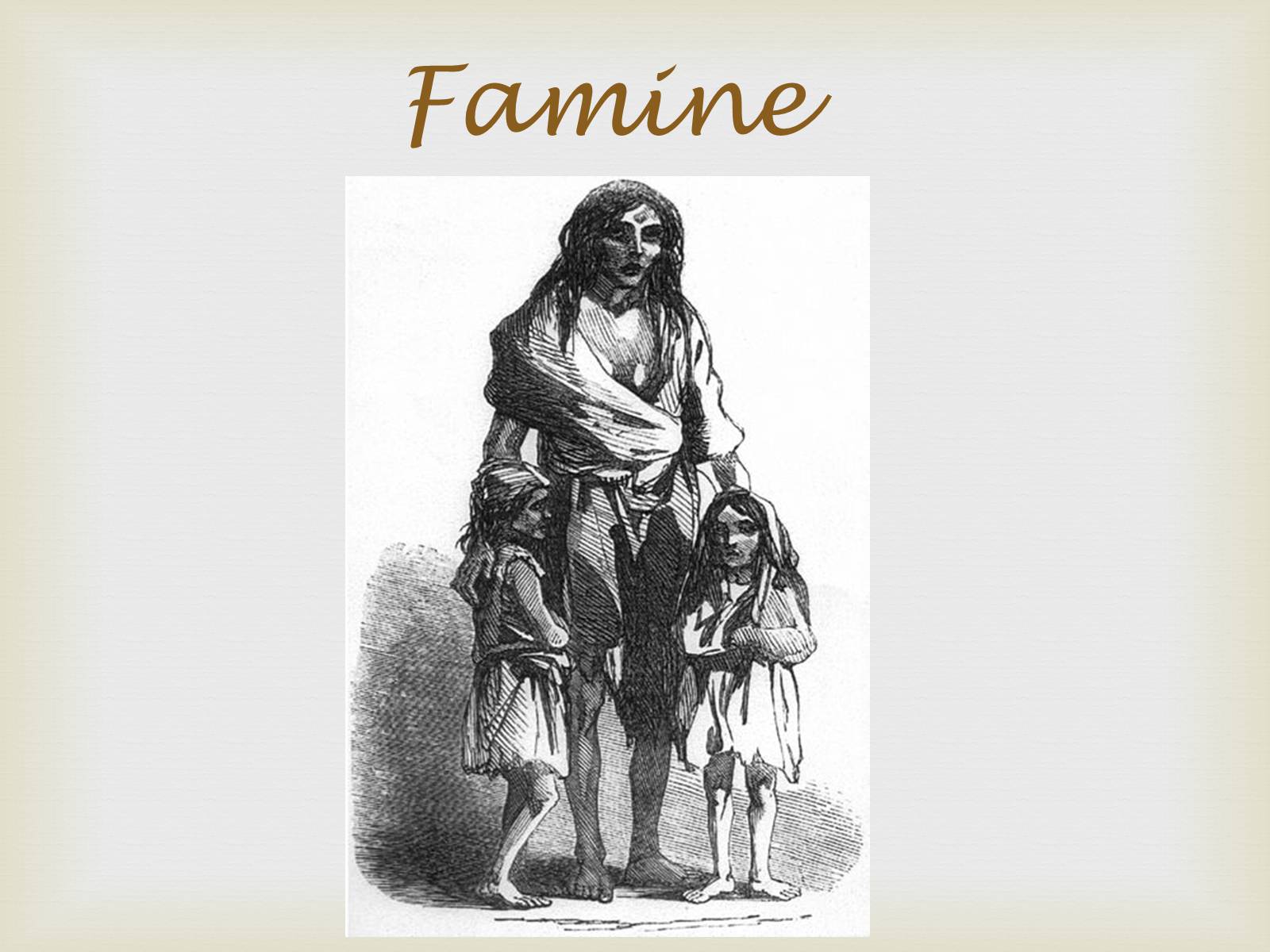
Слайд #19
Famine
A famine is a widespread scarcity of food,caused by several factors including crop failure, population unbalance, or government policies. This phenomenon is usually accompanied or followed by regional malnutrition, starvation, epidemic, and increased mortality. Nearly every continent in the world has experienced a period of famine throughout history. Some countries, particularly in sub-Sahara Africa, continue to have extreme cases of famine.
The famine relief model increasingly used by aid groups calls for giving cash or cash vouchers to the hungry to pay local farmers instead of buying food from donor countries, as is often required by law (for example U.S. law requires that food aid money be spent on food grown in the U.S.), as it wastes money on transport costs,but more importantly, it perpetuates the cycle of dependency on foreign imports rather than helping to create real local stability through agricultural abundance. Emergency measures in relieving famine include providing high calorie ready-to-use therapeutic food (RUTF), through fortified sachets of peanut-based paste such as Plumpy'nut that are given primarily to children.
Long-term measures include investment in modern agriculture techniques, such as fertilizers and irrigation, which largely eradicated hunger in the developed world.World Bank strictures restrict government subsidies for farmers, and increasing use of fertilizers is opposed by some environmental groups because of its unintended consequences: adverse effects on water supplies and habitat
A famine is a widespread scarcity of food,caused by several factors including crop failure, population unbalance, or government policies. This phenomenon is usually accompanied or followed by regional malnutrition, starvation, epidemic, and increased mortality. Nearly every continent in the world has experienced a period of famine throughout history. Some countries, particularly in sub-Sahara Africa, continue to have extreme cases of famine.
The famine relief model increasingly used by aid groups calls for giving cash or cash vouchers to the hungry to pay local farmers instead of buying food from donor countries, as is often required by law (for example U.S. law requires that food aid money be spent on food grown in the U.S.), as it wastes money on transport costs,but more importantly, it perpetuates the cycle of dependency on foreign imports rather than helping to create real local stability through agricultural abundance. Emergency measures in relieving famine include providing high calorie ready-to-use therapeutic food (RUTF), through fortified sachets of peanut-based paste such as Plumpy'nut that are given primarily to children.
Long-term measures include investment in modern agriculture techniques, such as fertilizers and irrigation, which largely eradicated hunger in the developed world.World Bank strictures restrict government subsidies for farmers, and increasing use of fertilizers is opposed by some environmental groups because of its unintended consequences: adverse effects on water supplies and habitat
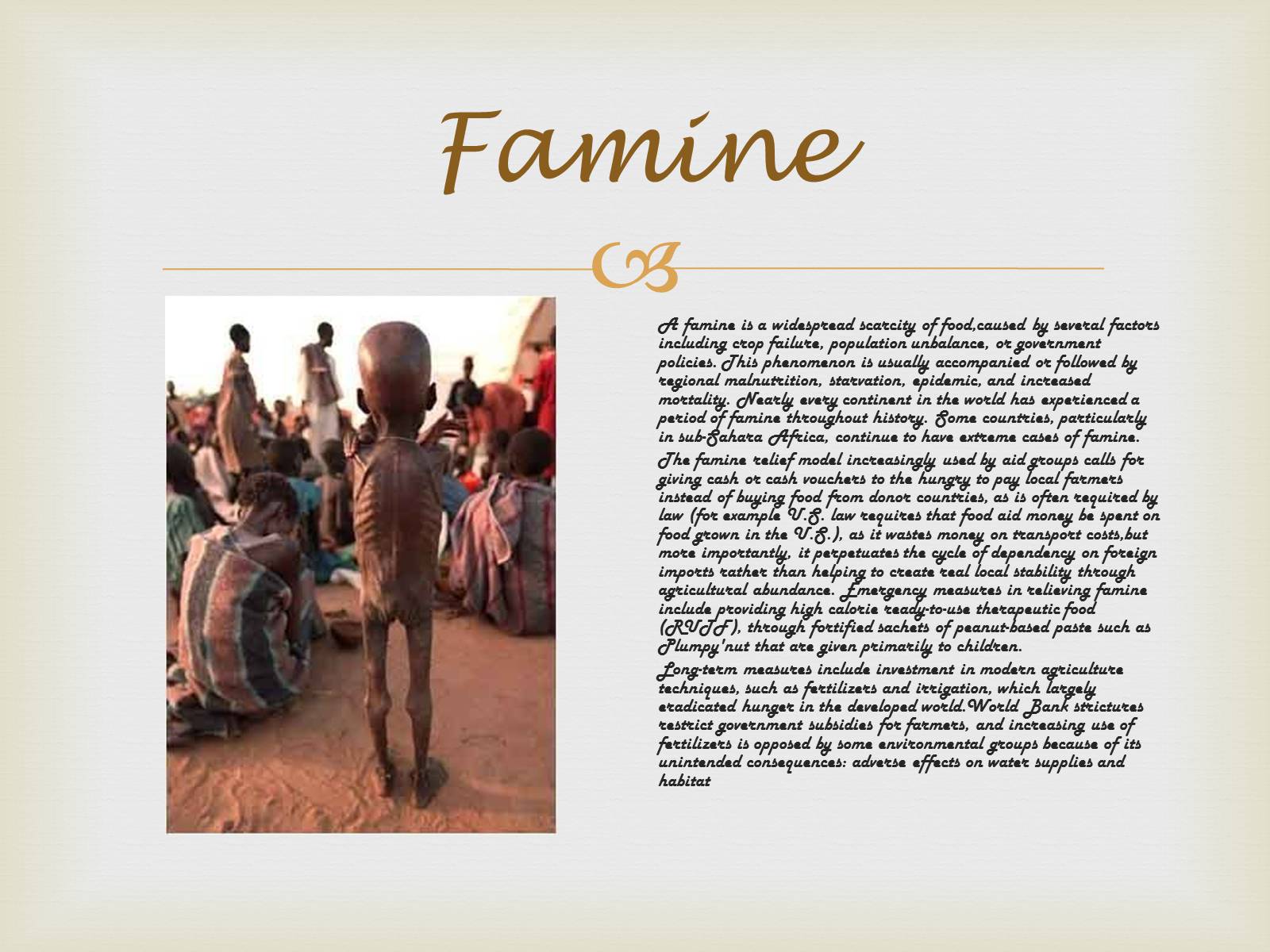
Слайд #20
Causes
Definitions of famines are based on three different categories – these include food supply-based, food consumption-based and mortality-based definitions. Some definitions of famines are:
Blix – Widespread food shortage leading to significant rise in regional death rates.
Brown and Eckholm – Sudden, sharp reduction in food supply resulting in widespread hunger.
Scrimshaw – Sudden collapse in level of food consumption of large numbers of people.
Ravallion – Unusually high mortality with unusually severe threat to food intake of some segments of a population.
Cuny – A set of conditions that occurs when large numbers of people in a region cannot obtain sufficient food, resulting in widespread, acute malnutrition.
Food shortages in a population are caused either by a lack of food or by difficulties in food distribution; it may be worsened by natural climate fluctuations and by extreme political conditions related to oppressive government or warfare. One of the proportionally largest historical famines was the Bengal Famine of 1770 in the lower Gangetic plain of East India Company ruled North East India. It began in 1770 due to severe extractive practices of the East India CompanyAn estimated ten million people died in the famine, roughly one in three people in the affected area.The deaths were greatly exacerbated by the fact that the East India Company raised land taxes by 10% at the height of the famine, in April 1770.
The conventional explanation until 1981 for the cause of famines was the Food availability decline (FAD) hypothesis. The assumption was that the central cause of all famines was a decline in food availability.However, FAD could not explain why only a certain section of the population such as the agricultural laborer was affected by famines while others were insulated from famines.Based on the studies of some recent famines, the decisive role of FAD has been questioned and it has been suggested that the causal mechanism for precipitating starvation includes many variables other than just decline of food availability. According to this view, famines are a result of entitlements, the theory being proposed is called the "failure of exchange entitlements" or FEE.A person may own various commodities that can be exchanged in a market economy for the other commodities he or she needs. The exchange can happen via trading or production or through a combination of the two. These entitlements are called trade-based or production-based entitlements. Per this proposed view, famines are precipitated due to a break down in the ability of the person to exchange his entitlements.An example of famines due to FEE is the inability of an agricultural laborer to exchange his primary entitlement, i.e., labor for rice when his employment became erratic or was completely eliminated.Some elements make a particular region more vulnerable to famine. These include:
Poverty
Inappropriate social infrastructure
A suppressive political regime
A weak or under-prepared government
Definitions of famines are based on three different categories – these include food supply-based, food consumption-based and mortality-based definitions. Some definitions of famines are:
Blix – Widespread food shortage leading to significant rise in regional death rates.
Brown and Eckholm – Sudden, sharp reduction in food supply resulting in widespread hunger.
Scrimshaw – Sudden collapse in level of food consumption of large numbers of people.
Ravallion – Unusually high mortality with unusually severe threat to food intake of some segments of a population.
Cuny – A set of conditions that occurs when large numbers of people in a region cannot obtain sufficient food, resulting in widespread, acute malnutrition.
Food shortages in a population are caused either by a lack of food or by difficulties in food distribution; it may be worsened by natural climate fluctuations and by extreme political conditions related to oppressive government or warfare. One of the proportionally largest historical famines was the Bengal Famine of 1770 in the lower Gangetic plain of East India Company ruled North East India. It began in 1770 due to severe extractive practices of the East India CompanyAn estimated ten million people died in the famine, roughly one in three people in the affected area.The deaths were greatly exacerbated by the fact that the East India Company raised land taxes by 10% at the height of the famine, in April 1770.
The conventional explanation until 1981 for the cause of famines was the Food availability decline (FAD) hypothesis. The assumption was that the central cause of all famines was a decline in food availability.However, FAD could not explain why only a certain section of the population such as the agricultural laborer was affected by famines while others were insulated from famines.Based on the studies of some recent famines, the decisive role of FAD has been questioned and it has been suggested that the causal mechanism for precipitating starvation includes many variables other than just decline of food availability. According to this view, famines are a result of entitlements, the theory being proposed is called the "failure of exchange entitlements" or FEE.A person may own various commodities that can be exchanged in a market economy for the other commodities he or she needs. The exchange can happen via trading or production or through a combination of the two. These entitlements are called trade-based or production-based entitlements. Per this proposed view, famines are precipitated due to a break down in the ability of the person to exchange his entitlements.An example of famines due to FEE is the inability of an agricultural laborer to exchange his primary entitlement, i.e., labor for rice when his employment became erratic or was completely eliminated.Some elements make a particular region more vulnerable to famine. These include:
Poverty
Inappropriate social infrastructure
A suppressive political regime
A weak or under-prepared government
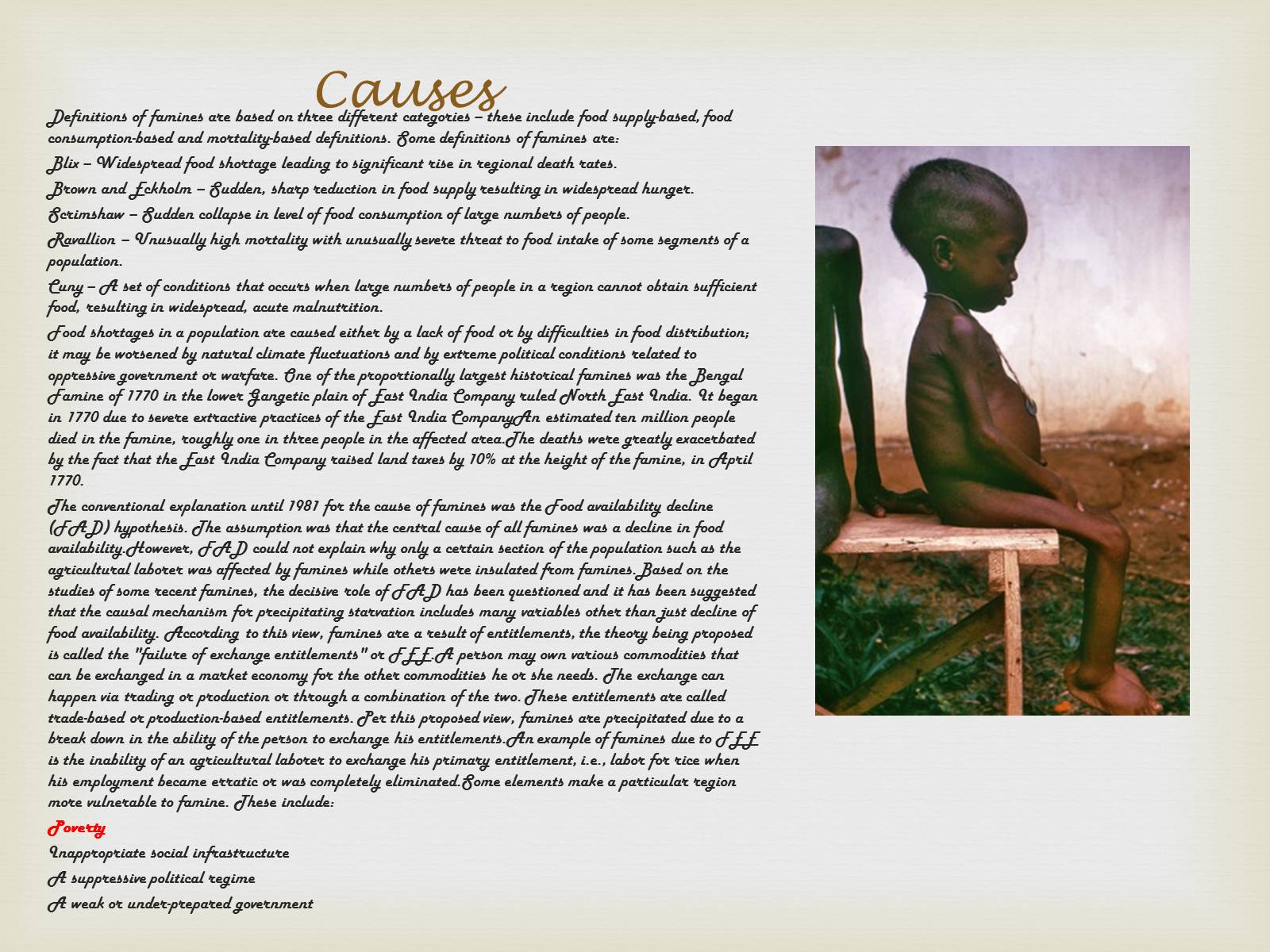
Слайд #21
History
During the 20th century, an estimated 70 million people died from famines across the world, of whom an estimated 30 million died during the famine of 1958–61 in China.The other most notable famines of the century included the 1942–1945 disaster in Bengal, famines in China in 1928 and 1942, and a sequence of famines in the Soviet Union, including the Soviet famine of 1932-1933, Stalin's famine inflicted on USSR in 1932–33. A few of the great famines of the late 20th century were: the Biafran famine in the 1960s, the Khmer Rouge-caused famine in Cambodia in the 1970s, the Ethiopian famine of 1984–85 and the North Korean famine of the 1990s.
During the 20th century, an estimated 70 million people died from famines across the world, of whom an estimated 30 million died during the famine of 1958–61 in China.The other most notable famines of the century included the 1942–1945 disaster in Bengal, famines in China in 1928 and 1942, and a sequence of famines in the Soviet Union, including the Soviet famine of 1932-1933, Stalin's famine inflicted on USSR in 1932–33. A few of the great famines of the late 20th century were: the Biafran famine in the 1960s, the Khmer Rouge-caused famine in Cambodia in the 1970s, the Ethiopian famine of 1984–85 and the North Korean famine of the 1990s.

Слайд #22
Africa
An account from the First Intermediate Period states, "All of Upper Egypt was dying of hunger and people were eating their children." In 1680s, famine extended across the entire Sahel, and in 1738 half the population of Timbuktu died of famine.I n Egypt, between 1687 and 1731, there were six famines.The famine that afflicted Egypt in 1784 cost it roughly one-sixth of its population.At the end of the 18th century,[66] and even more at the beginning of the nineteenth, the Maghreb suffered from the deadly combination of plague and famine.Tripoli and Tunis experienced famine in 1784 and 1785 respectively.
According to John Iliffe, "Portuguese records of Angola from the 16th century show that a great famine occurred on average every seventy years; accompanied by epidemic disease, it might kill one-third or one-half of the population, destroying the demographic growth of a generation and forcing colonists back into the river valleys."
With famine reigning over Africa, corruption in governments and foreign aid started to become more prevalent. National governments have control over each of these to varying degrees, although their implementation varies regionally. On the other hand, donors and corporations sometimes build infrastructures and give loans such as the world banks and NATO, but the continued protection and aid depends on the governments and agencies. One common theme in foreign aid and how it is disrupted is a correlation between geography and food security along with class, ethnicity, gender and religion. Foreign aid tends to find its way into hands that don't need it in corrupt governments, siphoning it away from the poor. Taking the aid away from the people that really need it slows the pace of development and progress ultimately undermines the welfare of citizens.
The First Documentation of weather in West-Central Africa occurs around the mid sixteenth-seventeenth centuries in areas such as Luanda Kongo, however, not much data was recorded on the issues of weather and disease except for a few notable documents. The only records obtained are of violence between Portuguese and Africans during the battle of mbilwa in 1665. In these documents the Portuguese wrote of African raids on Portuguese merchants solely for food, giving clear signs of famine. Additionally, Instances of Cannibalism by the African Jaga were also more prevalent during this time frame, indicating an extreme deprivation of a primary food source.
An account from the First Intermediate Period states, "All of Upper Egypt was dying of hunger and people were eating their children." In 1680s, famine extended across the entire Sahel, and in 1738 half the population of Timbuktu died of famine.I n Egypt, between 1687 and 1731, there were six famines.The famine that afflicted Egypt in 1784 cost it roughly one-sixth of its population.At the end of the 18th century,[66] and even more at the beginning of the nineteenth, the Maghreb suffered from the deadly combination of plague and famine.Tripoli and Tunis experienced famine in 1784 and 1785 respectively.
According to John Iliffe, "Portuguese records of Angola from the 16th century show that a great famine occurred on average every seventy years; accompanied by epidemic disease, it might kill one-third or one-half of the population, destroying the demographic growth of a generation and forcing colonists back into the river valleys."
With famine reigning over Africa, corruption in governments and foreign aid started to become more prevalent. National governments have control over each of these to varying degrees, although their implementation varies regionally. On the other hand, donors and corporations sometimes build infrastructures and give loans such as the world banks and NATO, but the continued protection and aid depends on the governments and agencies. One common theme in foreign aid and how it is disrupted is a correlation between geography and food security along with class, ethnicity, gender and religion. Foreign aid tends to find its way into hands that don't need it in corrupt governments, siphoning it away from the poor. Taking the aid away from the people that really need it slows the pace of development and progress ultimately undermines the welfare of citizens.
The First Documentation of weather in West-Central Africa occurs around the mid sixteenth-seventeenth centuries in areas such as Luanda Kongo, however, not much data was recorded on the issues of weather and disease except for a few notable documents. The only records obtained are of violence between Portuguese and Africans during the battle of mbilwa in 1665. In these documents the Portuguese wrote of African raids on Portuguese merchants solely for food, giving clear signs of famine. Additionally, Instances of Cannibalism by the African Jaga were also more prevalent during this time frame, indicating an extreme deprivation of a primary food source.
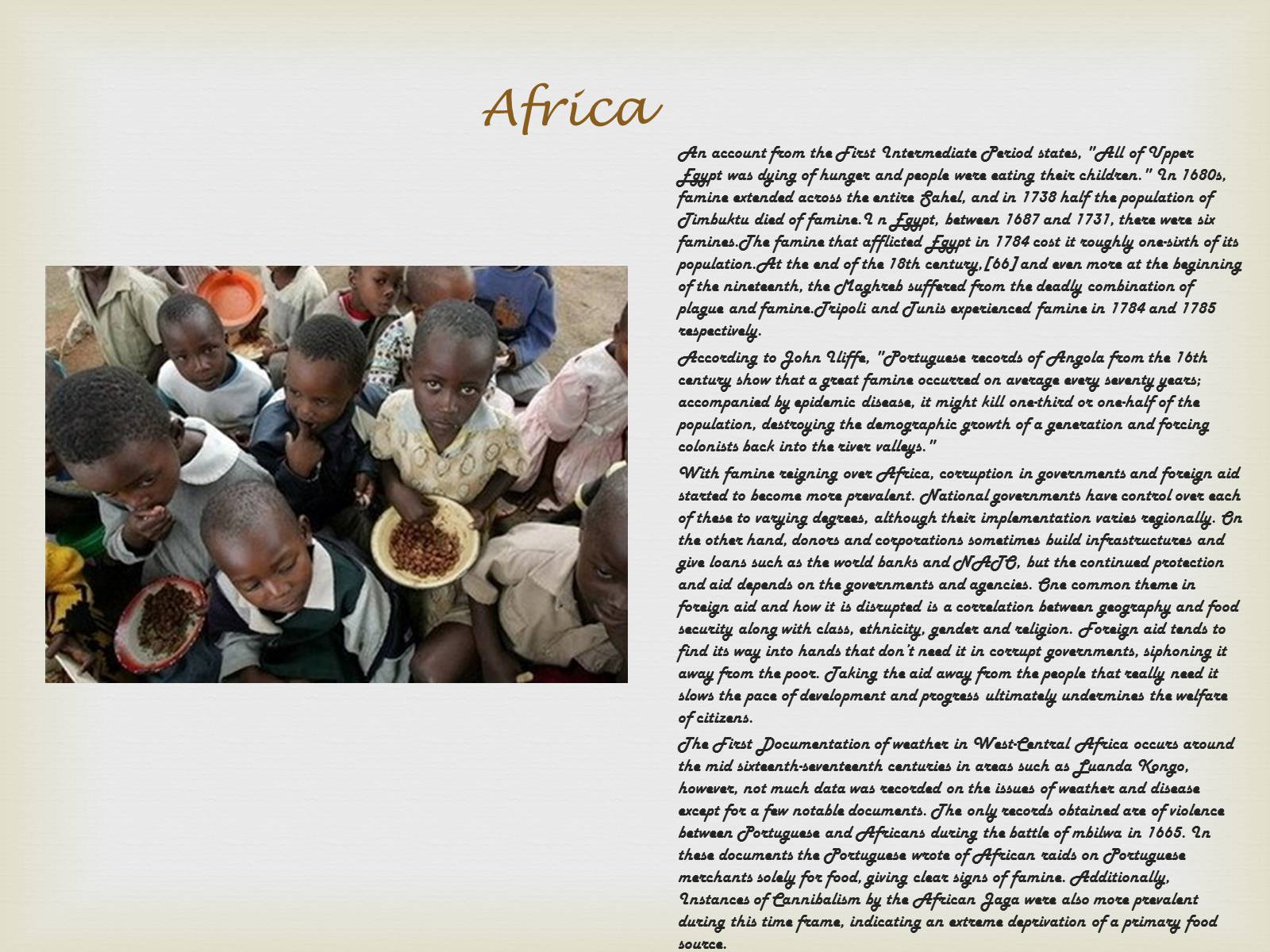
Слайд #23
Africa
An account from the First Intermediate Period states, "All of Upper Egypt was dying of hunger and people were eating their children." In 1680s, famine extended across the entire Sahel, and in 1738 half the population of Timbuktu died of famine.I n Egypt, between 1687 and 1731, there were six famines.The famine that afflicted Egypt in 1784 cost it roughly one-sixth of its population.At the end of the 18th century,[66] and even more at the beginning of the nineteenth, the Maghreb suffered from the deadly combination of plague and famine.Tripoli and Tunis experienced famine in 1784 and 1785 respectively.
According to John Iliffe, "Portuguese records of Angola from the 16th century show that a great famine occurred on average every seventy years; accompanied by epidemic disease, it might kill one-third or one-half of the population, destroying the demographic growth of a generation and forcing colonists back into the river valleys."
With famine reigning over Africa, corruption in governments and foreign aid started to become more prevalent. National governments have control over each of these to varying degrees, although their implementation varies regionally. On the other hand, donors and corporations sometimes build infrastructures and give loans such as the world banks and NATO, but the continued protection and aid depends on the governments and agencies. One common theme in foreign aid and how it is disrupted is a correlation between geography and food security along with class, ethnicity, gender and religion. Foreign aid tends to find its way into hands that don't need it in corrupt governments, siphoning it away from the poor. Taking the aid away from the people that really need it slows the pace of development and progress ultimately undermines the welfare of citizens.
The First Documentation of weather in West-Central Africa occurs around the mid sixteenth-seventeenth centuries in areas such as Luanda Kongo, however, not much data was recorded on the issues of weather and disease except for a few notable documents. The only records obtained are of violence between Portuguese and Africans during the battle of mbilwa in 1665. In these documents the Portuguese wrote of African raids on Portuguese merchants solely for food, giving clear signs of famine. Additionally, Instances of Cannibalism by the African Jaga were also more prevalent during this time frame, indicating an extreme deprivation of a primary food source.
An account from the First Intermediate Period states, "All of Upper Egypt was dying of hunger and people were eating their children." In 1680s, famine extended across the entire Sahel, and in 1738 half the population of Timbuktu died of famine.I n Egypt, between 1687 and 1731, there were six famines.The famine that afflicted Egypt in 1784 cost it roughly one-sixth of its population.At the end of the 18th century,[66] and even more at the beginning of the nineteenth, the Maghreb suffered from the deadly combination of plague and famine.Tripoli and Tunis experienced famine in 1784 and 1785 respectively.
According to John Iliffe, "Portuguese records of Angola from the 16th century show that a great famine occurred on average every seventy years; accompanied by epidemic disease, it might kill one-third or one-half of the population, destroying the demographic growth of a generation and forcing colonists back into the river valleys."
With famine reigning over Africa, corruption in governments and foreign aid started to become more prevalent. National governments have control over each of these to varying degrees, although their implementation varies regionally. On the other hand, donors and corporations sometimes build infrastructures and give loans such as the world banks and NATO, but the continued protection and aid depends on the governments and agencies. One common theme in foreign aid and how it is disrupted is a correlation between geography and food security along with class, ethnicity, gender and religion. Foreign aid tends to find its way into hands that don't need it in corrupt governments, siphoning it away from the poor. Taking the aid away from the people that really need it slows the pace of development and progress ultimately undermines the welfare of citizens.
The First Documentation of weather in West-Central Africa occurs around the mid sixteenth-seventeenth centuries in areas such as Luanda Kongo, however, not much data was recorded on the issues of weather and disease except for a few notable documents. The only records obtained are of violence between Portuguese and Africans during the battle of mbilwa in 1665. In these documents the Portuguese wrote of African raids on Portuguese merchants solely for food, giving clear signs of famine. Additionally, Instances of Cannibalism by the African Jaga were also more prevalent during this time frame, indicating an extreme deprivation of a primary food source.
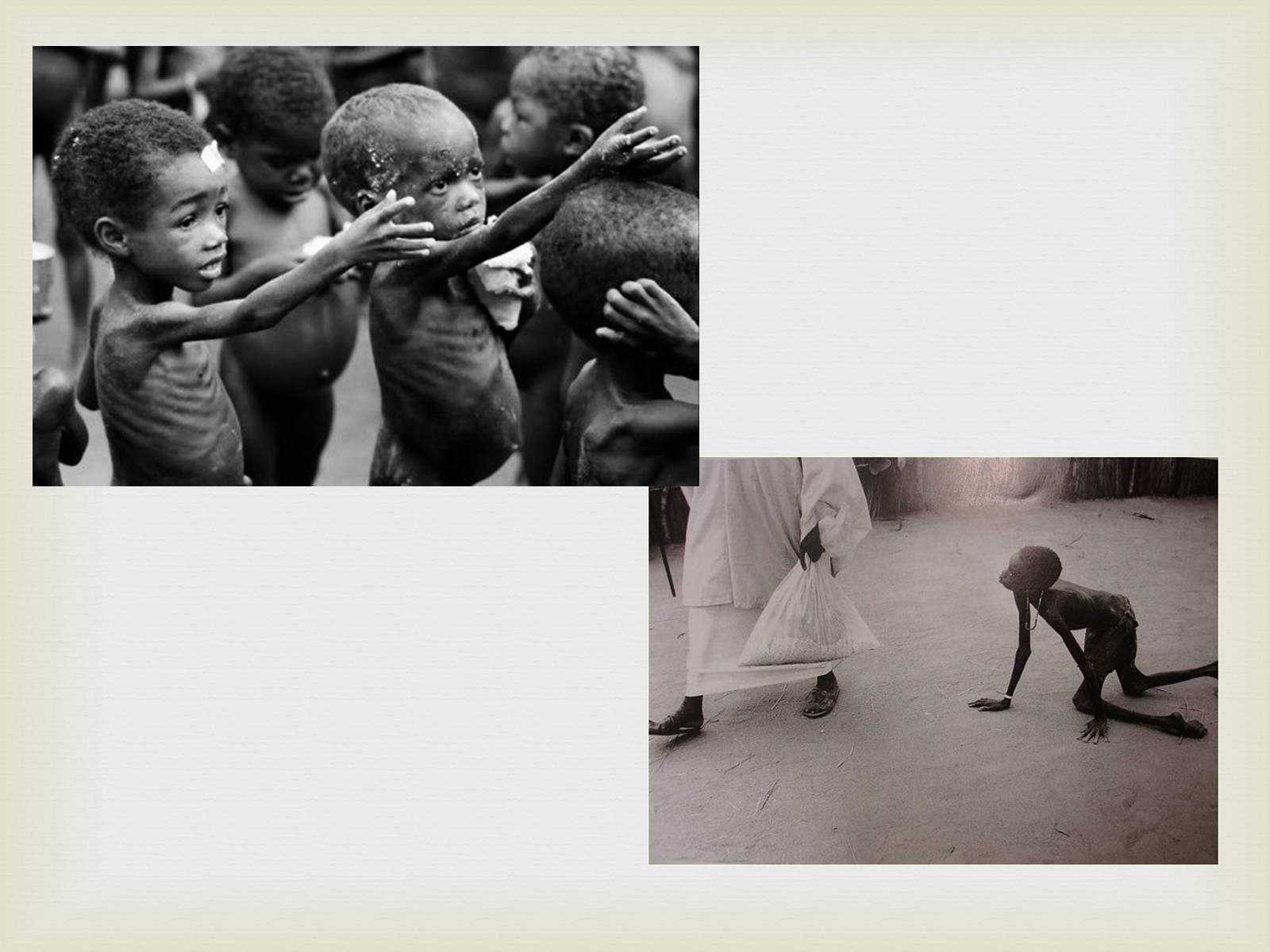
Слайд #24
Italy
The harvest failures were devastating for the northern Italian economy. The economy of the area had recovered well from the previous famines, but the famines from 1618 to 1621 coincided because of a period of war in the area. The economy did not recover fully for centuries. There were serious famines in the late-1640s and less severe ones in the 1670s throughout northern Italy.
In northern Italy, a report of 1767 noted that there had been famine in 111 of the previous 316 years (i.e. the period 1451-1767) and only sixteen good harvests.
According to Stephen L. Dyson and Robert J. Rowland, "The Jesuits of Cagliari [in Sardinia] recorded years during the late 1500s "of such hunger and so sterile that the majority of the people could sustain life only with wild ferns and other weeds" ... During the terrible famine of 1680, some 80,000 persons, out of a total population of 250,000, are said to have died, and entire villages were devastated..."
The harvest failures were devastating for the northern Italian economy. The economy of the area had recovered well from the previous famines, but the famines from 1618 to 1621 coincided because of a period of war in the area. The economy did not recover fully for centuries. There were serious famines in the late-1640s and less severe ones in the 1670s throughout northern Italy.
In northern Italy, a report of 1767 noted that there had been famine in 111 of the previous 316 years (i.e. the period 1451-1767) and only sixteen good harvests.
According to Stephen L. Dyson and Robert J. Rowland, "The Jesuits of Cagliari [in Sardinia] recorded years during the late 1500s "of such hunger and so sterile that the majority of the people could sustain life only with wild ferns and other weeds" ... During the terrible famine of 1680, some 80,000 persons, out of a total population of 250,000, are said to have died, and entire villages were devastated..."
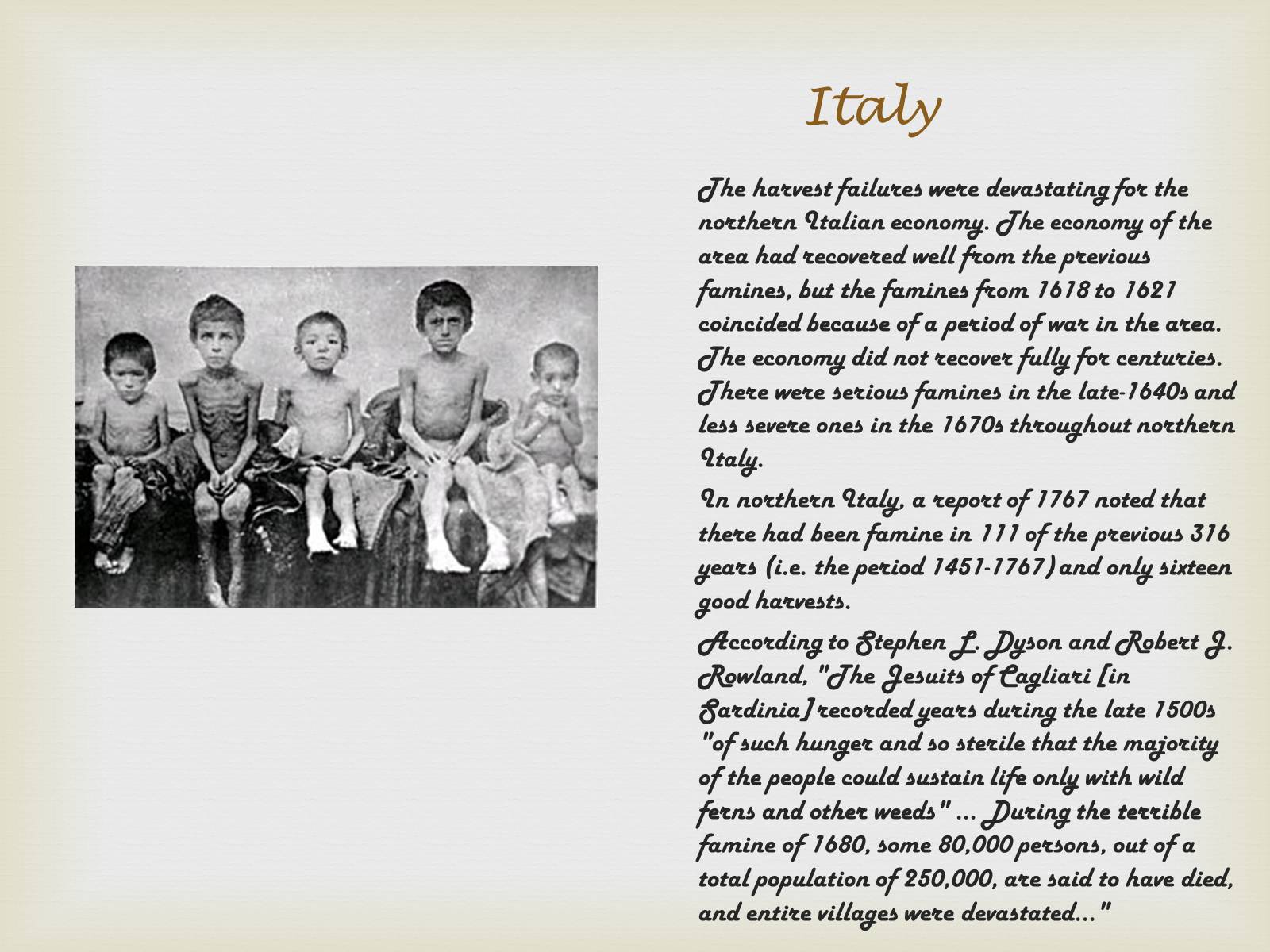
Слайд #25
Ireland
The Great Famine in Ireland, 1845–1849, was caused in part by policies of the Whig government of the United Kingdom under Lord Russell. The land in Ireland was owned mostly by Anglican people of English descent, who did not identify culturally or ethnically with the Irish population. The landlords were known as the Anglo-Irish and felt no compulsion to use their political clout to aid their tenants and in fact saw it as an opportunity to claim more land for high profit cattle grazing as the Irish died off or left. The British government's response to the food crisis in Ireland was to leave the matter solely to market forces to decide. In reality, since the British had forcefully taken the land from the native Irish over the centuries the Irish had little means to support themselves beyond the meager amount of land set aside for the potato crop. The potato had been grown by the Irish as it is a very high calorie per acre yield. Even if the Irish were able to obtain other crops they would not have been enough to support the population on the small amount of land allocated to them, only a potato crop could do that. Ireland was a net food exporter during the famine with the British army guarding ports and food depots from the starving crowds.
The immediate effect was 1,000,000 dead and another 2,000,000 refugees fleeing to Britain, Australia and the United States.[124] After the famine passed, infertility caused by famine, diseases and emigration spurred by the landlord-run economy being so thoroughly undermined, caused the population to enter into a 100-year decline. It was not until the 1970s (half a century after most of Ireland became independent) that the population of Ireland, then at half of what it had been before the famine, began to rise again. This period of Irish population decline after the famine was at a time when the European population doubled and the English population increased fourfold. This left the country severely underpopulated. The population decline continued in parts of the country worst affected by the famine (the west coast) until the 1990s - 150 years after the famine. Before the Hunger, Ireland's population was over half of England's. Today it is less than 10%. The population of Ireland is 5 million but there are over 80 million more people of Irish descent outside of Ireland. That is sixteen times the population of Ireland.
The Great Famine in Ireland, 1845–1849, was caused in part by policies of the Whig government of the United Kingdom under Lord Russell. The land in Ireland was owned mostly by Anglican people of English descent, who did not identify culturally or ethnically with the Irish population. The landlords were known as the Anglo-Irish and felt no compulsion to use their political clout to aid their tenants and in fact saw it as an opportunity to claim more land for high profit cattle grazing as the Irish died off or left. The British government's response to the food crisis in Ireland was to leave the matter solely to market forces to decide. In reality, since the British had forcefully taken the land from the native Irish over the centuries the Irish had little means to support themselves beyond the meager amount of land set aside for the potato crop. The potato had been grown by the Irish as it is a very high calorie per acre yield. Even if the Irish were able to obtain other crops they would not have been enough to support the population on the small amount of land allocated to them, only a potato crop could do that. Ireland was a net food exporter during the famine with the British army guarding ports and food depots from the starving crowds.
The immediate effect was 1,000,000 dead and another 2,000,000 refugees fleeing to Britain, Australia and the United States.[124] After the famine passed, infertility caused by famine, diseases and emigration spurred by the landlord-run economy being so thoroughly undermined, caused the population to enter into a 100-year decline. It was not until the 1970s (half a century after most of Ireland became independent) that the population of Ireland, then at half of what it had been before the famine, began to rise again. This period of Irish population decline after the famine was at a time when the European population doubled and the English population increased fourfold. This left the country severely underpopulated. The population decline continued in parts of the country worst affected by the famine (the west coast) until the 1990s - 150 years after the famine. Before the Hunger, Ireland's population was over half of England's. Today it is less than 10%. The population of Ireland is 5 million but there are over 80 million more people of Irish descent outside of Ireland. That is sixteen times the population of Ireland.
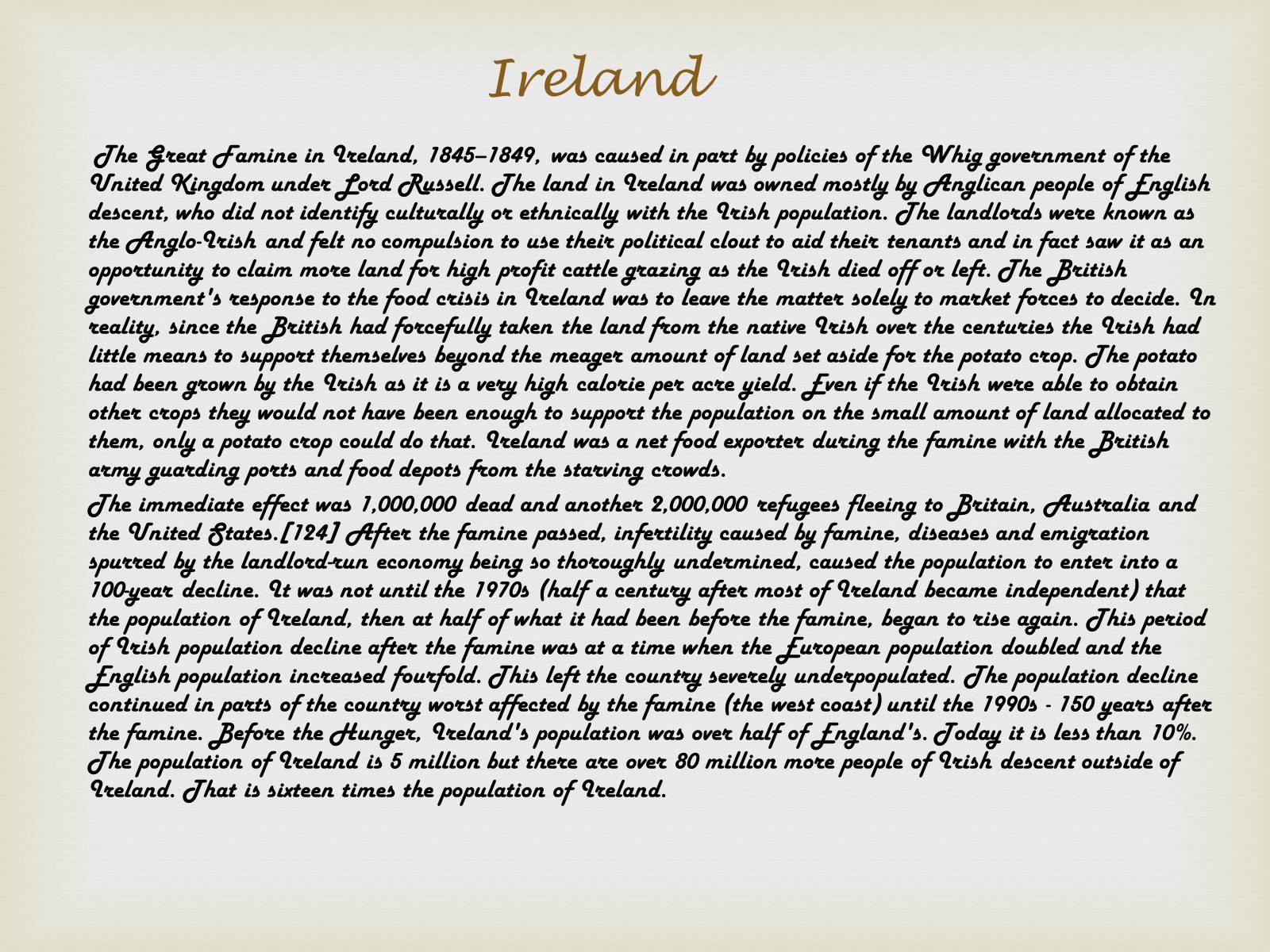
Слайд #26
Famine Memorial in Dublin
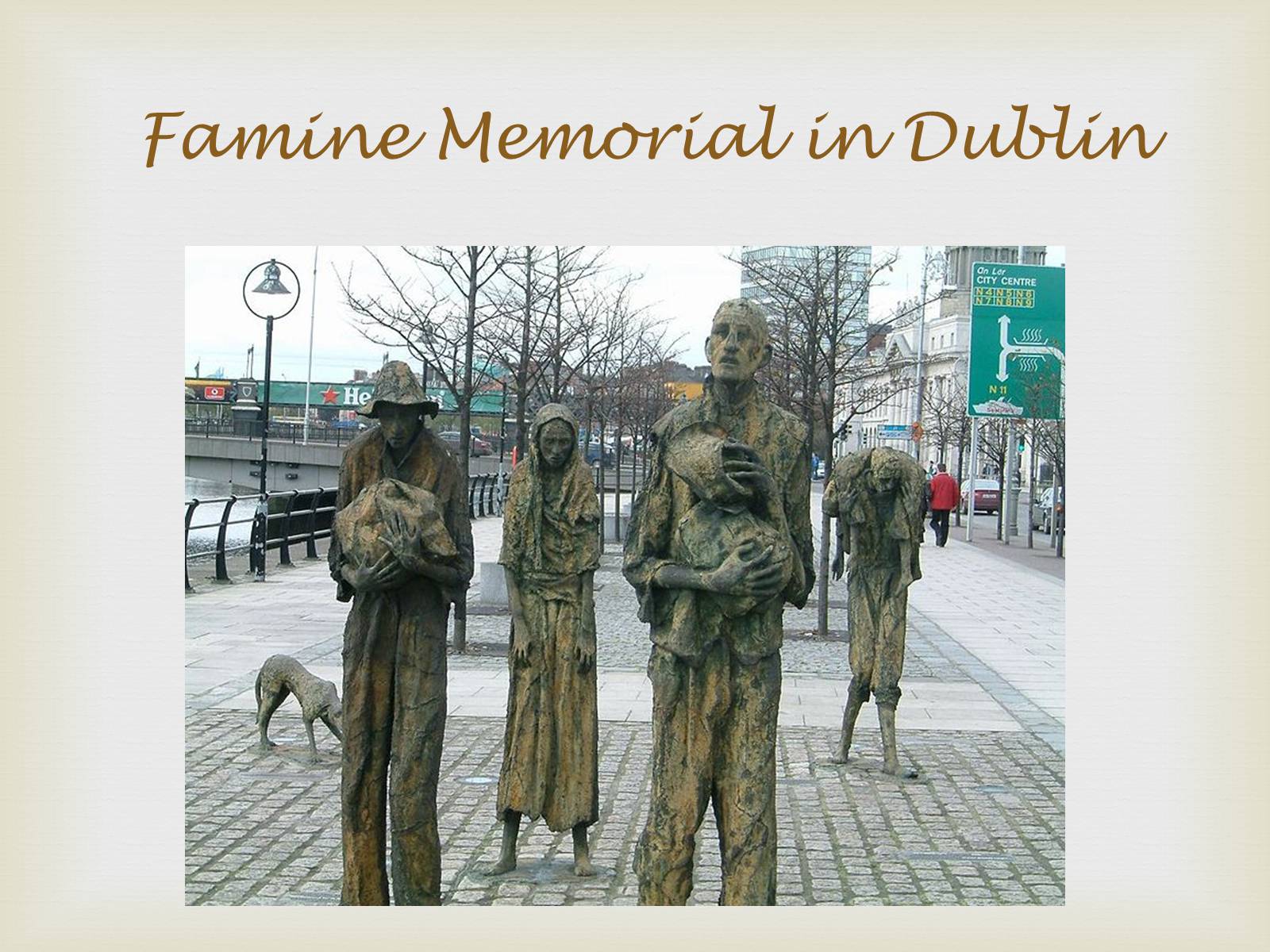
Слайд #27
Droughts and famines in Russia and the Soviet Union
Droughts and famines in Russia and the Soviet Union tended to occur on a fairly regular basis, with famine occurring every 10–13 years and droughts every 5–7 years. Golubev and Dronin distinguish three types of drought according to productive areas vulnerable to droughts: Central (Volga basin, Northern Caucasus and Central Chernozem Region), Southern (Volga and Volga-Vyatka area, Ural, Ukraine), and Eastern (steppe and forest-steppe belts Western and Eastern Siberia and Kazakhstan).
Droughts and famines in Russia and the Soviet Union tended to occur on a fairly regular basis, with famine occurring every 10–13 years and droughts every 5–7 years. Golubev and Dronin distinguish three types of drought according to productive areas vulnerable to droughts: Central (Volga basin, Northern Caucasus and Central Chernozem Region), Southern (Volga and Volga-Vyatka area, Ural, Ukraine), and Eastern (steppe and forest-steppe belts Western and Eastern Siberia and Kazakhstan).
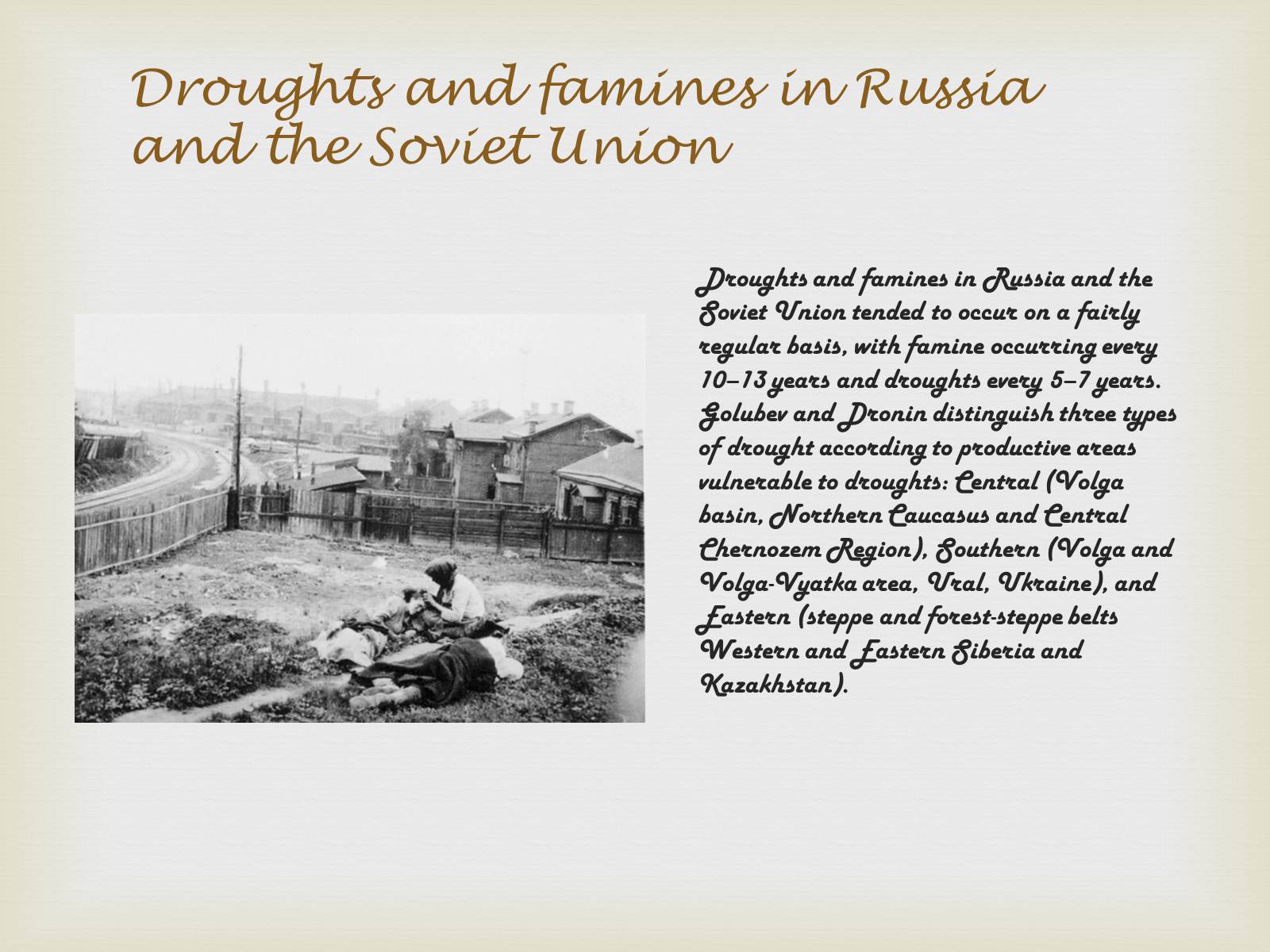
Слайд #28
Post 1900 Droughts and Famines
The Golubev and Dronin report gives the following table of the major droughts in Russia.
Central: 1920, 1924, 1936, 1946, 1972, 1979, 1981, 1984.
Southern: 1901, 1906, 1921, 1939, 1948, 1951, 1957, 1975, 1995.
Eastern: 1911, 1931, 1963, 1965, 1991.
The first famine in the USSR happened in 1921-1923 and garnered wide international attention. It was mostly due to forceful confiscation of grain and other policies of the Soviet government . The most affected area being the Southeastern areas of European Russia (including Volga area, or Povolzhye, especially national republics of Idel-Ural, see 1921-1922 Famine in Tatarstan) and Ukraine. Fridtjof Nansen was honored with the 1922 Nobel Prize for Peace, in part for his work as High Commissioner for Relief In Russia. Other organizations that helped to combat the Soviet famine were UISE (Union Internationale de Secours aux Enfants, International Save the Children Union) and the International Red Cross.
The second Soviet famine happened during the collectivisation in the USSR. In 1932-1933 confiscations of grain and other food by the Soviet authorities caused a famine which affected more than 40 million people, especially in the south on the Don and Kuban areas and in Ukraine, where by various estimates from 5 to 10 million may have starved to death (the event known as Holodomor).Estimates of deaths due to the 1932-1933 famine vary wildly, but are typically given in the range of millions. About 200,000 Kazakh nomads fled to China, Iran, Mongolia and Afghanistan during the famine.
Although famines were taking place in various parts of the USSR in 1932-33, for example in Kazakhstan .parts of Russia and the Volga German Republic,the name Holodomor is specifically applied to the events that took place in territories populated by ethnic Ukrainians.
The last major famine in the USSR happened mainly in 1947 as a cumulative effect of consequences of collectivization, war damage, the severe drought in 1946 in over 50% of the grain-productive zone of the country and government social policy and mismanagement of grain reserves.
The drought of 1963 caused panic slaughtering of livestock, but there was no risk of famine. Since that year the Soviet Union started importing feed grains for its livestock in increasing amounts.
Russia has been gripped in a severe drought from July 2010, which may see grain production fall by 20-25%.
The Golubev and Dronin report gives the following table of the major droughts in Russia.
Central: 1920, 1924, 1936, 1946, 1972, 1979, 1981, 1984.
Southern: 1901, 1906, 1921, 1939, 1948, 1951, 1957, 1975, 1995.
Eastern: 1911, 1931, 1963, 1965, 1991.
The first famine in the USSR happened in 1921-1923 and garnered wide international attention. It was mostly due to forceful confiscation of grain and other policies of the Soviet government . The most affected area being the Southeastern areas of European Russia (including Volga area, or Povolzhye, especially national republics of Idel-Ural, see 1921-1922 Famine in Tatarstan) and Ukraine. Fridtjof Nansen was honored with the 1922 Nobel Prize for Peace, in part for his work as High Commissioner for Relief In Russia. Other organizations that helped to combat the Soviet famine were UISE (Union Internationale de Secours aux Enfants, International Save the Children Union) and the International Red Cross.
The second Soviet famine happened during the collectivisation in the USSR. In 1932-1933 confiscations of grain and other food by the Soviet authorities caused a famine which affected more than 40 million people, especially in the south on the Don and Kuban areas and in Ukraine, where by various estimates from 5 to 10 million may have starved to death (the event known as Holodomor).Estimates of deaths due to the 1932-1933 famine vary wildly, but are typically given in the range of millions. About 200,000 Kazakh nomads fled to China, Iran, Mongolia and Afghanistan during the famine.
Although famines were taking place in various parts of the USSR in 1932-33, for example in Kazakhstan .parts of Russia and the Volga German Republic,the name Holodomor is specifically applied to the events that took place in territories populated by ethnic Ukrainians.
The last major famine in the USSR happened mainly in 1947 as a cumulative effect of consequences of collectivization, war damage, the severe drought in 1946 in over 50% of the grain-productive zone of the country and government social policy and mismanagement of grain reserves.
The drought of 1963 caused panic slaughtering of livestock, but there was no risk of famine. Since that year the Soviet Union started importing feed grains for its livestock in increasing amounts.
Russia has been gripped in a severe drought from July 2010, which may see grain production fall by 20-25%.
